
How to Write a Synthesis Essay: Your Guide From Start to Finish

Today, we're swamped with information, like reading 174 newspapers every day. It comes from all over—news, social media, science, and more. This flood might make you feel overwhelmed and lost in a sea of facts and opinions. But being able to make sense of it all is crucial.
This guide isn't just about handling all that info; it's about using it to write awesome essays. We'll show you step by step how to pick a topic and organize your essay. Let's dive in and learn how to turn scattered facts into powerful essays that really stand out.
What Is a Synthesis Essay
The synthesis essay is a powerful tool in writing. It's not just about gathering facts but about connecting them to make a clear and strong argument.
Writing a synthesis essay allows you to dive deep into ideas. You have to find similarities between different sources—like articles, studies, or arguments—and use them to tell a convincing story.
In today's world, where we're bombarded with information, synthesis essays are more important than ever. They let us explore how different ideas fit together and help us express our thoughts on complex topics. Whether you're writing about literature, science, history, or current events, a synthesis essay shows off your ability to analyze and understand a topic from all angles. And if you're struggling with this task, just ask us to ' write paper for me ,' and we'll handle your assignment for you.
Explanatory vs. Argumentative Synthesis Essays
In synthesis writing, there are two main types: explanatory and argumentative. Understanding these categories is key because they shape how you approach your essay.
Explanatory:
An explanatory synthesis essay does just what it says—it explains. These essays aim to give a balanced view of a topic by gathering information from different sources and presenting it clearly. They don't try to persuade; instead, they focus on providing information and making things easier to understand. They're like comprehensive summaries, breaking down complex ideas for a broader audience. These essays rely heavily on facts and expert opinions, avoiding personal bias.
Argumentative:
On the flip side, argumentative synthesis essays are all about persuasion. Their main goal is to take a stance on an issue and convince the reader. They gather information from various sources not only to present different views but also to build a strong argument. Argumentative essays aim to sway the reader's opinion by using gathered information as evidence. These essays express opinions and use rhetorical strategies to persuade.
And if you're keen on knowing how to write an informative essay , we've got you covered on that, too!
Synthesis Essay Structure
To craft a strong synthesis essay, you need a solid foundation. Here's a structured approach to help you nail it:
Introductory Paragraph:
- To kick things off, grab your reader's attention with a catchy hook or interesting fact. Give a bit of background info about your topic and the sources you'll be using, as it can help readers understand your topic better! Then, lay out your main argument in a clear thesis statement.
Body Paragraphs:
- Each paragraph should focus on a different aspect of your topic or source. Start with a topic sentence that links back to your thesis. Introduce the source you're discussing and highlight its main points. Also, using quotes, paraphrases, or summaries from your sources can make your arguments stronger.
Synthesis :
- This part is where your essay comes together. Look for common themes or differences among your sources. Use your analysis to build a strong argument. Don't forget to address any opposing viewpoints if they're relevant!
Conclusion :
- Wrap things up by restating your thesis and summarizing your main points. Explain why your argument is important and what it means in the bigger picture. End with a thought-provoking statement to leave a lasting impression.
References :
- Finally, don't forget to list all your sources properly using the right citation style, like MLA or APA. Do you know that different citation styles have different rules? So, make sure you follow the right one!
Choosing a Synthesis Essay Topic
Picking essay topics is just the beginning. To write a great synthesis essay, you need to carefully evaluate and connect different sources to build a strong argument or viewpoint. Here's a step-by-step infographic guide to help you choose the right synthesis essay topics wisely.

How to Write a Synthesis Essay with Easy Steps
Writing a synthesis essay is similar to a compare and contrast essay . It requires a methodical approach to blend information from different sources into a strong and persuasive argument. Here are some crucial steps and tips to help you along the way.
- Clarify Your Purpose: First, decide if you're writing an explanatory or argumentative synthesis essay. This choice will set the tone and direction for your essay.
- Source Selection and Analysis: Choose credible and relevant sources for your topic, balancing different types like articles, books, and websites. Analyze each source carefully, noting the main ideas and evidence presented.
- Formulate a Strong Thesis Statement: Create a clear and concise thesis statement that guides your essay. It should express your main argument or perspective.
- Structure Your Essay: Organize your essay with a clear synthesis essay outline, including an introduction, body paragraphs, and a conclusion. Each body paragraph should focus on a specific aspect of your topic.
- Employ Effective Transition Sentences: Use transition sentences to connect your ideas and paragraphs smoothly, ensuring a cohesive flow in your essay.
- Synthesize Information: Blend information from your sources within your paragraphs. Discuss how each source contributes to your thesis and highlight common themes or differences.
- Avoid Simple Summarization: Don't just summarize your sources—analyze them critically and use them to build your argument.
- Address Counterarguments (if applicable): Acknowledge opposing viewpoints and counter them with well-supported arguments, showing a deep understanding of the topic.
- Craft a Resolute Conclusion: Summarize your main points and restate your thesis in the conclusion. Emphasize the importance of your argument or insights, and end with a thought-provoking statement or call to action.
- Revise and Proofread: Check your essay for clarity, coherence, and grammar mistakes. Ensure your citations are correct and follow the chosen citation style, like MLA or APA.
Ready to Transform Your Synthesis Essay from Bland to Grand?
Let's tap into the magic of our expert wordsmiths, who will create an essay that dances with ideas and dazzles with creativity!
Synthesis Essay Format
Choosing the right citation style can enhance the credibility and professionalism of your paper. The format of your synthesis paper depends on the specific guidelines given by your instructor. They usually fall into one of the popular styles: MLA, APA, or Chicago, each used in different academic fields.

1. MLA (Modern Language Association):
- Uses in-text citations with the author's last name and page number.
- Includes a 'Works Cited' page at the end listing all sources.
- Focuses on the author and publication date.
- Often used in humanities essays, research papers, and literary analyses.
2. APA (American Psychological Association):
- Uses in-text citations with the author's last name and publication date in parentheses.
- Includes a 'References' page listing all sources alphabetically.
- Emphasizes the publication date and scientific precision.
- Commonly used in research papers, scholarly articles, and scientific studies.
3. Chicago Style:
- Offers two documentation styles: Notes-Bibliography and Author-Date.
- Notes-Bibliography uses footnotes or endnotes for citations, while Author-Date uses in-text citations with a reference list.
- Suitable for various academic writing, including research papers and historical studies.
- Provides flexibility in formatting and citation methods, making it adaptable to different disciplines.
Synthesis Essay Example
Here are two examples of synthesis essays that demonstrate how to apply the synthesis process in real life. They explore interesting topics and offer practical guidance for mastering the art of writing this type of paper.
Synthesis Essay Tips
Crafting a strong synthesis essay requires careful planning and effective techniques. Here are five essential tips to help you write your best paper:
- Diverse Source Selection : Choose a range of reliable sources that offer different viewpoints on your topic. Make sure they're recent and relevant to your subject.
- Seamless Source Integration : Avoid just summarizing your sources. Instead, blend them into your essay by analyzing and comparing their ideas. Show how they connect to build your argument.
- Balanced Tone : Maintain an impartial tone in your writing, even if you have personal opinions. Synthesis essays require objectivity, so they present different viewpoints without bias.
- Focus on Synthesis : Remember, synthesis essays are about linking ideas, not just summarizing sources. Explore how your sources relate to each other to create a cohesive argument.
- Address Counterarguments : Like in persuasive essays topics , acknowledge opposing viewpoints and explain why your perspective is stronger. This demonstrates your understanding of the topic and adds depth to your argument.
Concluding Thoughts
When writing a synthesis essay, it's essential to pick trustworthy sources, blend them effectively to build your argument and stay objective. Use smooth transitions, address counterarguments thoughtfully, and focus on analyzing rather than just summarizing. By following these steps, you'll create essays that inform, persuade, and engage your readers!
Want an Essay that Sings, Sparkles, and Stuns?
Fear not! Our expert wordsmiths are here to turn your thoughts into a symphony of ideas!
How Should You Conclude a Synthesis Essay?

Daniel Parker
is a seasoned educational writer focusing on scholarship guidance, research papers, and various forms of academic essays including reflective and narrative essays. His expertise also extends to detailed case studies. A scholar with a background in English Literature and Education, Daniel’s work on EssayPro blog aims to support students in achieving academic excellence and securing scholarships. His hobbies include reading classic literature and participating in academic forums.

is an expert in nursing and healthcare, with a strong background in history, law, and literature. Holding advanced degrees in nursing and public health, his analytical approach and comprehensive knowledge help students navigate complex topics. On EssayPro blog, Adam provides insightful articles on everything from historical analysis to the intricacies of healthcare policies. In his downtime, he enjoys historical documentaries and volunteering at local clinics.
Related Articles
.webp)
- Essay Editor
Synthesis Essay Examples

A synthesis essay is another piece of academic discourse that students often find difficult to write. This assignment indeed requires a more nuanced approach to writing and performing research. It’s particularly relevant to students taking an AP English Language and Composition exam, so learning how to write a synthesis essay is crucial to getting a high score.
This article will explore the definition of a synthesis essay, its functions, and objectives, and provide a tutorial on how to write a synthesis essay.
What is a synthesis essay?
To understand how to write a synthesis essay, we first need to figure out why it is called this way.
The word “synthesis” comes from the Greek language where it means “composition” or “collection.” This means that a synthesis essay can be interpreted as a piece of writing that combines something together. But what?
The Advanced Placement (AP) Program known for developing complex courses for high-school students includes a synthesis essay as one of its Language and Composition exam questions. In it, the AP Program asks students to analyze several sources of information and write an essay that “synthesizes” (or incorporates) evidence from some of the sources.
Thus, a synthesis essay is a written text that explores a certain issue using perspectives derived from multiple different sources.
Synthesis essay: format and objectives
Unlike other types of academic analysis, synthesis questions do not aim to evaluate the overall persuasiveness of your arguments. As a writer, you should aim to analyze, evaluate, and integrate diverse ideas into a coherent whole. Here are some of the skills students need to demonstrate in their synthesis essays:
- Analyzing sources . Before you learn how to start a synthesis essay, your task is to read and analyze the sources presented to you and understand what they’re about.
- Assessing the arguments . After familiarizing yourself with the available sources, you are supposed to evaluate if the arguments they support are strong or weak, which will help you determine the course of your essay.
- Identifying common positions . The next skill you must demonstrate is identifying common positions across the sources. By comparing and contrasting different viewpoints, the writer should be able to detect repeating ideas that contribute to a deeper understanding of the topic.
- Integrating sources . Your main task in a synthesis essay is combining ideas from different authors to create a cohesive argument. This will help you show how well you can extract information from various sources.
As you see, the chief goal of synthesis questions is to show how well you can analyze sources and derive information from them.
How to start a synthesis essay: tutorial
During an AP examination, you don’t have a lot of time to write the text. It can be stressful, and it’s not rare for students to panic and forget what to do. Don’t worry, with these simple steps, you’ll be able to create a great synthesis essay and ace your exam.
1. Scan the given sources
At first, you will be handed six sources that you’re supposed to briefly examine. These can include academic and newspaper articles, graphs, schedules, prompts, and other documents that can be used to support your future thesis statement.
Remember that you don’t have a lot of time, so take a quick look at the documents and leave short remarks that can help you remember which source supports or argues a certain opinion.
2. Develop your stance
After you’ve studied the sources, it’s time to come up with your stance and thesis statement. Note that, unlike other essays, the stance you must take in your synthesis essay might not correlate with your actual opinion.
Your task is to choose a position that you can support with the sources provided to you. This will showcase your ability to draw an unbiased and logical conclusion from a wide range of references. However, your stance should express an original idea and cannot paraphrase the points given in the source texts.
3. Write your essay
Your essay should start with a two or three-sentence-long introduction that gives background to the topic you’re going to be writing about. It should also include your thesis – the idea based on the evidence you’ve gathered that you’re going to defend in the next part of your essay. Don’t use personal pronouns as a synthesis essay provides an overview of facts instead of your opinion
The body of your synthesis essay should be built of several arguments. Each argument should refer to a specific part of your thesis and provide evidence to support the claims. Use the sources provided to you as evidence to validate your arguments. You should use at least three sources, but the more you incorporate in your text, the better. You can draw arguments and evidence from your background knowledge or include counter-arguments from the remaining sources. When you refer to the original documents, make sure to include the number of the source in brackets at the end of a sentence.
In your conclusion, restate your original thesis and summarize what you stated before. Don’t repeat the same thoughts. Instead, include a new idea you haven’t mentioned before or a call to action to finish your essay properly.
Synthesis essay: examples
The list of sources provided as part of the examination:
- A New York Times article about the relevance of blue-collar workers;
- A Washington Post article about the uselessness of art degrees;
- The Economist’s article about the decreasing wages of college graduates;
- A New Your Times article proving that college does pay off;
- An article about a businessman giving money to teens to start businesses instead of going to college
- A survey on whether college education is worth it
Is college worth it?
In the current era of shifting economic landscapes and evolving societal expectations, the value of higher education has become a subject of intense scrutiny. While some decades ago, a college education was considered the only solution to a better life, nowadays this sentiment is no longer relevant. Higher education can no longer guarantee high salaries and employment, not to mention the unbearable strain it puts on a future graduate’s finances.
The modern world of employment has shifted. While decades ago society needed information-centric professionals, now the situation is different. With the Internet, employers can now find new hires from all over the world with much cheaper salary expectations, leaving local college graduates with no choice but to agree to a lower pay than they expected[3]. This demonstrates the new trend of decreasing rewards for higher education that is very likely to continue in the future.
Another issue is the lack of employment in certain areas. It is no secret that Art and Humanities graduates have a tough time finding positions with adequate pay in the field they studied[2]. Many of them have to search for employment in other fields that have nothing to do with their degrees, which further proves that higher education does not provide job security.
Furthermore, the cost of higher education in America has been the subject of many debates. Even with scholarships and financial aid, many students still find themselves facing daunting loan repayments upon graduation[6]. This financial pressure can delay important milestones such as buying a home, starting a family, or saving for retirement. Additionally, the job market may not always align with graduates' expectations, making it challenging to secure well-paying positions to effectively manage their debt. As a result, the financial impact of college can be felt long after receiving a diploma, shaping the economic landscape of young professionals for years to come.
In conclusion, higher education no longer offers guaranteed employment and financial stability benefits, often leaving graduates with an exorbitant debt they can not afford. Because of this, the governments should reevaluate their current educational and economic policies and develop other areas of education like vocational schools to provide stability to future generations.
Conclusion: Writing a synthesis essay
A synthesis essay tests your ability to conduct objective analysis and derive facts from multiple different references. It helps you learn to put aside your personal bias and provide an objective overview of information even if it contradicts your opinion. To produce a high-scoring synthesis essay, work on your analytical skills and use them to find evidence to defend your position.
If answering synthesis questions gives you trouble, use essay generator Aithor to generate sample essays, learn how to derive main information from source texts, create a plan, and express your thoughts concisely and eloquently.
Related articles
How to write an evaluation essay that engages and persuades: helpful tips and inspiring examples.
Are you feeling unsure about how to effectively evaluate a subject from your own perspective in an evaluation essay? If you're struggling to understand how to present a balanced assessment, don't worry! We're here to guide you through the process of writing an evaluation that showcases your critical thinking skills. What Is an Evaluation Essay? An evaluation essay is a type of writing in which the writer gives their opinion on a topic. You look at something carefully and think about how good ...
Literary Analysis Essay Example: Discover How to Analyze Literature and Improve Your Writing Skills
Creating a literary analysis essay is one of the most interesting assignments during college and high school studies. It needs both good text interpreting and analytical skills. The number of proper forms is great, including short stories and novels, poems and ballads, comedies and dramas. Any literary work may be analyzed. In brief, when writing this paper a student should give a summary of the text and a detailed review of the language, structure, and other stuff the author used to express hi ...
Create a Perfect Essay Structure
Hello Aithors! We're back again with another feature highlight. Today, we want to talk about a tool that can be a game-changer for your essay writing process - our Table of Contents tool. Writing an essay isn't just about getting your ideas down on paper. It's about presenting them in a clear, structured way that makes sense to your reader. However, figuring out the best structure for your essay can sometimes be a tough nut to crack. That's why we developed the Table of Contents feature. The b ...
How To Write Reflection Essays
How often do you contemplate how the tapestry of your experiences shapes your thoughts? A reflection paper lets you explore that. It's like deep diving into your life’s precious moments, examining how stories, books, events, or even lectures have influenced your views. This type of academic essay integrates a personal perspective, allowing you to openly express your opinions. In this guide, we will delve into the specifics of reflective writing, share some tips, and show some self-reflection es ...
Ace Your Graduation Speech with Aithor
Hello, Aithors! Can you feel it? That's the buzz of graduation season in the air:) And while we're all about the caps flying and the proud smiles, we also know that being asked to write a graduation speech can feel a bit like being handed a mountain to climb. Crafting a graduation speech is all about capturing the spirit of the journey you've been on, from the triumphs to the trials, and everything in between. It's a reflection of where you've been, and a beacon of light pointing towards where ...
Biographical Essay: Tips and Tricks for Writing a Perfect Biography
Biographical essays are some of the most common texts you can find on the Internet. When you browse a Wiki article about your favorite singer, you are basically reading a biography paper. However, in academia, there are certain rules students need to follow to get perfect marks for their papers. In this article, we will explore what a biographical essay is, why it matters, and how to write an essay about a person. What is a biographical essay? A biographical essay is a paper that focuses on ...
Will I Get Caught Using Chat GPT?
ChatGPT has been around for a little over a year but already found popularity among all groups of users. School and college students have taken a particular liking to it. However, many students avoid using the chatbot for fear that their teacher might catch them. Read this article to learn more about ChatGPT, its features, and whether your teacher can actually find out if you use it for your homework. What is Chat GPT? ChatGPT was first introduced to the world in November 2022. At the time, ...
Proposal Essay Examples: Convincing Ideas for Your Research Paper or Essay
Struggling to craft a captivating and well-built proposal essay? Many students find it challenging to compose a proposal-based essay and struggle to generate convincing ideas. If this sounds familiar, read on. In this comprehensive guide, we streamline the process of brainstorming and composing work, offering resources like suggestions on how to write a proposal essay, suggested steps when writing, useful examples, and efficient essay-crafting tips. Developed through several years of expertise ...
📕 Studying HQ
How to write a synthesis essays, carla johnson.
- June 14, 2023
- How to Guides
Synthesis essays are a common type of academic writing that asks students to put together information from different sources into a coherent argument or point of view about a certain topic. In a synthesis essay, students must analyze and combine information from different sources, such as articles, books, and other academic materials, to come up with a new way of looking at a certain issue or idea.
The importance of synthesis essays lies in the fact that they help students learn how to think critically, analyze information, and communicate effectively. By putting together information from different sources, students can learn more about complicated topics and form their own opinions about them.
Synthesis essays are important in the classroom, but they are also useful in the real world , such as in business, politics, and other professional fields. In many fields, it is important to be able to combine information from different sources into a coherent argument. This skill can help people communicate better and make better decisions.
In the sections that follow, we’ll talk about the most important parts of a good synthesis essay, such as how to find and analyze information, make a convincing argument, and explain your ideas to your audience. By learning how to write synthesis essays well, students can learn important skills that will help them both in school and in the workplace.
What You'll Learn
Elements of a Synthesis Essay
A synthesis essay uses information from more than one source to make an argument or point of view about a certain topic. Here are the most important parts of a good synthesis essay:
1. The purpose of a synthesis essay: The goal of a synthesis essay is to analyze and combine information from different sources into a new way of looking at a certain issue or idea. The essay should have a clear, well-thought-out argument based on evidence and analysis.
2. Analysis and evaluation of sources: To write a good synthesis essay, it’s important to carefully read and think about each source that will be used. This means judging the credibility and reliability of each source and figuring out how each source fits into the argument as a whole.
3. Creation of a thesis statement: The main idea or point of an essay is the thesis statement. It should be clear, short, and detailed, and it should sum up the main point or argument of the essay .
4. Integration of sources into the essay: Each source’s information should be put into the essay in a way that supports the overall argument. This means picking and arranging the information from each source carefully and putting it together in a way that is clear and easy to understand.
5. Development of a logical and coherent argument: The essay should be easy to understand and well-organized, with each paragraph building on the one before it to make a logical and coherent argument. Each paragraph should focus on a different part of the argument and use evidence and analysis from the sources to back it up.
Preparing to Write a Synthesis Essay
Preparing to write a synthesis essay involves several key steps, including:
1. Reading and analyzing sources: The first step in preparing to write a synthesis essay is to carefully read and analyze each source that will be used in the essay. This involves critically evaluating the credibility and reliability of each source, and identifying key themes, ideas, and arguments that will be relevant to the essay.
2. Brainstorming and outlining: Once the sources have been analyzed, the next step is to brainstorm ideas and create an outline for the essay . This involves identifying key themes and arguments that will be addressed in the essay , and organizing them into a logical and coherent structure.
3. Identifying a thesis statement: The thesis statement is the main argument or focus of the essay. Once the key themes and arguments have been identified, it is important to develop a clear and concise thesis statement that summarizes the main argument or perspective of the essay .
4. Developing a plan for integrating sources: The information from each source should be integrated into the essay in a way that supports the overall argument. This involves developing a plan for how each source will be used in the essay, and how the information from each source will be integrated into the overall argument.
By following these key steps, students can effectively prepare to write a successful synthesis essay that is grounded in evidence and analysis, and presents a unique perspective on a particular topic.
Writing a Synthesis Essay
Writing a successful synthesis essay requires careful planning and attention to detail. The following tips can help you to write an effective synthesis essay:
1. Introduction: Start with an attention-grabbing hook that provides context for the essay, and introduce the topic and purpose of the essay. Provide a clear and concise thesis statement that summarizes the main argument or focus of the essay.
2. Body paragraphs: The body of the essay should include several paragraphs that address different aspects of the topic, and integrate information from multiple sources to support your argument. Use specific examples and evidence to support your claims , and make sure that each paragraph focuses on a specific idea or theme.
3. Conclusion: Summarize the main points of the essay, restate the thesis statement, and provide a thoughtful reflection on what has been learned from the synthesis process. It should also include suggestions for further research or discussion.
4. Tone and style: Use a professional and objective tone when writing a synthesis essay. Avoid using overly emotional or biased language, and focus on presenting a well-supported argument that is grounded in evidence and analysis .
5. Grammar and mechanics: Pay careful attention to grammar, mechanics, and spelling when writing a synthesis essay. Use clear and concise language, and proofread your essay carefully to ensure that it is error-free.
Synthesis Essay Examples
To better understand how to write a synthesis essay, it can be helpful to examine examples of effective essays . Here are some key takeaways from successful synthesis essays:
1. Effective synthesis essays draw on a variety of sources to support a well-developed argument or perspective on a particular topic.
2. The best synthesis essays use a clear and logical structure to present information and ideas in a way that is easy to follow.
3. Successful synthesis essays use specific examples and evidence to support claims, and provide thoughtful analysis and evaluation of sources.
4. The most effective synthesis essays present a unique perspective on a particular topic, and offer insights or perspectives that are not readily available in other sources.
5. Finally, successful synthesis essays demonstrate strong writing skills, including a clear and concise writing style, good grammar and mechanics, and effective use of transitions and other writing devices.
By examining examples of effective synthesis essays, students can gain a deeper understanding of the key elements of successful synthesis writing, and develop their own skills and abilities in this important area of academic and professional writing.
Synthesis Essay Topics
Synthesis essays can cover a wide range of topics and subjects. Here are some examples of common synthesis essay topics:
1. Social issues and activism: This topic might include analysis and synthesis of information related to social justice, human rights, inequality, or activism.
2. Science and technology: This topic might include analysis and synthesis of information related to scientific research, technological advancements, or the impact of technology on society.
3. Politics and government : This topic might include analysis and synthesis of information related to government policies, political systems, or the impact of politics on society.
4. Education and learning: This topic might include analysis and synthesis of information related to educational practices, learning theories, or the role of education in society.
5. Culture and media : This topic might include analysis and synthesis of information related to popular culture, media messages, or the impact of media on society.
Synthesis Essay Outline
Creating an effective outline is an important step in the process of writing a synthesis essay. The following are some tips for creating an effective outline, as well as examples of synthesis essay outlines:
1. Basic outline structure: A simple outline for a synthesis essay should have an intro, body paragraphs, and a conclusion. The introduction should have a hook, set the scene for the essay , and have a clear statement of the essay’s main point. The body of the essay should be made up of several paragraphs that cover different parts of the topic . The conclusion should summarize the main points of the essay and offer a thoughtful reflection on what has been learned.
2. Tips for creating an effective outline: When making an outline for a synthesis essay, it is important to focus on the main argument or point of view of the essay and to organize the information from each source in a way that supports the overall argument. Use subheadings and bullet points to organize information and ideas, and make sure that each paragraph focuses on a single idea or theme.
3. Examples of synthesis essay outlines:
I. Introduction
– Hook
– Context
– Thesis statement
II. Body Paragraphs
– Analysis of source 1
– Analysis of source 2
– Integration of sources into the essay
– Development of a logical and coherent argument
III. Conclusion
– Summary of main points
– Reflection on what has been learned
– Suggestions for further research or discussion
Another example:
– Analysis of source 3
– Reflection on what was learned
By following these tips and examples, students can create effective outlines for their synthesis essays, which will help them to organize their ideas and information, and to create a clear and well-supported argument or perspective on a particular topic .
Frequently Asked Questions
1. what is a synthesis essay.
A synthesis essay is a type of academic writing that asks students to put together information from different sources into a coherent argument or point of view about a certain topic. The goal of a synthesis essay is to analyze and combine information from different sources into a new way of looking at a certain issue or idea.
2. What are the elements of a synthesis essay?
The parts of a synthesis essay are the essay’s purpose, the analysis and evaluation of sources, the creation of a thesis statement, the integration of sources into the essay, and the development of an argument that makes sense and flows well.
3. How do I choose a topic for a synthesis essay?
When choosing a topic for a synthesis essay, think about things that you are really interested in or know a lot about. Also, look for topics that are complicated and have many different sides. Social issues, science and technology, politics and the government, education and learning, culture and the media can all be used as topics.
4. How do I structure a synthesis essay?
The format of a synthesis essay should be clear and well-structured, with an introduction, body paragraphs, and a conclusion. The introduction should have a hook, set the scene for the essay, and have a clear statement of the essay’s main point. The body of the essay should be made up of several paragraphs that cover different parts of the topic. The conclusion should summarize the main points of the essay and offer a thoughtful reflection on what has been learned.
5. What are some tips for writing a successful synthesis essay?
Some tips for writing a good synthesis essay include carefully reading and analyzing sources, coming up with a clear and concise thesis statement, putting sources into the essay in a way that supports the overall argument , and making an argument that makes sense and flows well. It’s also important to use clear, concise language, pay attention to grammar and mechanics, and carefully proofread the essay before sending it in.
In conclusion , students need to learn how to write synthesis essays if they want to do well in school and in their careers. Students can make a well-supported argument or point of view on a certain topic if they know the key parts of a good synthesis essay and follow the steps for preparing, structuring, and writing the essay . Students can use the skills and techniques they learn in writing synthesis essays to communicate effectively and make well-informed decisions in a wide range of situations. This is true whether they are writing about social issues and activism, science and technology, politics and government, education and learning, or culture and media.
Start by filling this short order form order.studyinghq.com
And then follow the progressive flow.
Having an issue, chat with us here
Cathy, CS.
New Concept ? Let a subject expert write your paper for You
Have a subject expert write for you now, have a subject expert finish your paper for you, edit my paper for me, have an expert write your dissertation's chapter, popular topics.
Business Analysis Examples Essay Topics and Ideas How to Guides Nursing
- Nursing Solutions
- Study Guides
- Free College Essay Examples
- Privacy Policy
- Writing Service
- Discounts / Offers
Study Hub:
- Studying Blog
- Topic Ideas
- Business Studying
- Nursing Studying
- Literature and English Studying
Writing Tools
- Citation Generator
- Topic Generator
- Paraphrasing Tool
- Conclusion Maker
- Research Title Generator
- Thesis Statement Generator
- Summarizing Tool
- Terms and Conditions
- Confidentiality Policy
- Cookies Policy
- Refund and Revision Policy
Our samples and other types of content are meant for research and reference purposes only. We are strongly against plagiarism and academic dishonesty.
Contact Us:
📞 +15512677917
2012-2024 © studyinghq.com. All rights reserved
How to Write a Synthesis Essay: Examples, Topics, & Outline
A synthesis essay requires you to work with multiple sources. You combine the information gathered from them to present a well-rounded argument on a topic. Are you looking for the ultimate guide on synthesis essay writing? You’ve come to the right place!
In this guide by our custom writing team, you will find:
- a step-by-step writing guide;
- a list of 34 synthesis essay topics;
- a full essay sample in MLA format.
- 📚 Synthesis Essay Definition
- 📝 Essay Types
- ✅ Step-by-Step Guide
- ✍️ Topics & Prompts
- 📑 Example & Formatting Tips
📚 What Is a Synthesis Essay?
A synthesis essay is an assignment that requires a unique interpretation of a particular topic using several reliable sources. To write it, you need to understand, analyze, and synthesize information. That is why this type of essay is used in the AP Lang exam to assess students’ reasoning skills.
The key features of the synthesis essay are:
- Debatable topic . If your goal is to write a good synthesis essay, it’s necessary to choose an arguable topic. It’s best to choose something that people have different opinions about. This will allow you to use many sources with various viewpoints for your synthesis.
- Clear thesis statement. It’s a sentence that briefly describes the main idea of your essay.
- Reliable sources to prove your thesis . For a synthesis essay, your opinion is not enough. You also need to find the evidence. Keep in mind that simply reading an online encyclopedia won’t do; make sure to choose only reliable sources.
What Does It Mean to Synthesize Information?
Synthesis is a process that has huge importance in nature, science, and our everyday life. The word stems from Ancient Greek “synthesis,” which means “putting together.” In general, synthesis is the combination of components to form a connected whole.
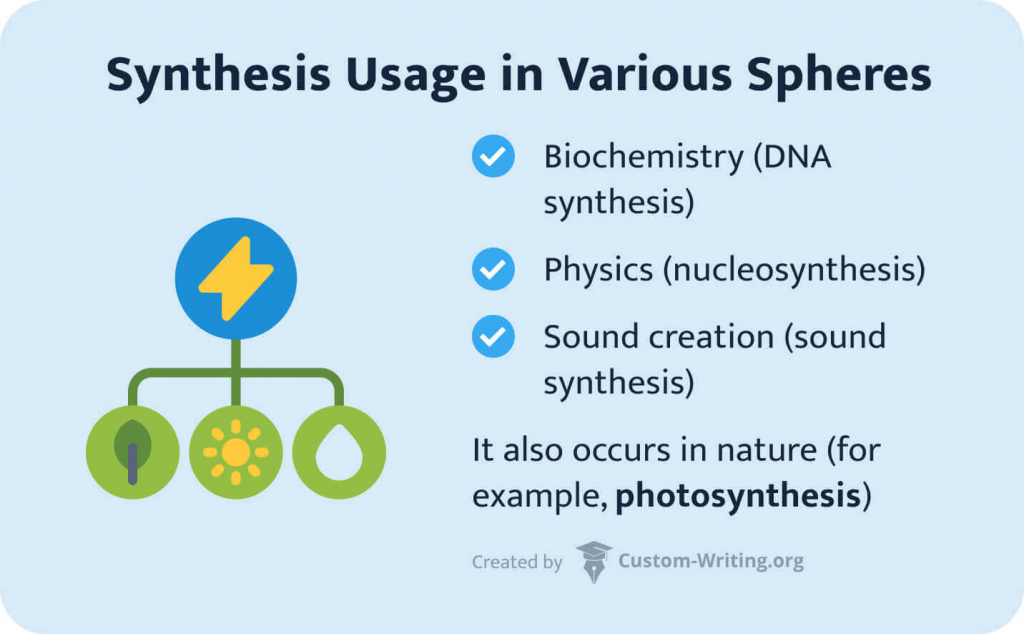
In everyday life, we usually resort to it to synthesize information . This means taking the data from different sources and bringing it together. This process is the opposite of analyzing:
- For an analysis , you break problems into pieces,
- For a synthesis , you combine separate elements into a whole.
We use synthesis for analysis papers, research papers, argument papers, and business reports.
What Does Synthesis Mean in Writing?
Synthesis in writing means summarizing and connecting different sources considering a particular topic. Although synthesis and analysis are two opposite things, they usually go together in synthesis essays. The process consists of 2 stages:
- Conduct the analysis. For that, you break down a problem into parts and analyze the sources. It’s helpful to highlight everything regarding your topic while reading.
- Carry out the synthesis. The next step is to formulate an opinion and combine the highlighted information from the sources.
Synthesis is not only used in writing but also in reading comprehension . It’s useful to do this kind of reading while studying your sources. There are three reading comprehension stages:
- Your previous knowledge about the topic.
- Expansion of your knowledge while you are reading.
- Understanding of the problem when you have finished reading.
So, synthesized reading comprehension means combining three stages in one and formulating one statement.
Synthesis vs Summary: What Is the Difference?
A summary is a paraphrasing of the written source in your own words. For a good summary, it’s necessary to include all of the text’s key elements. Meanwhile, synthesis means combining different ideas from different sources. You don’t have to include all the key points; just choose everything related to your topic.
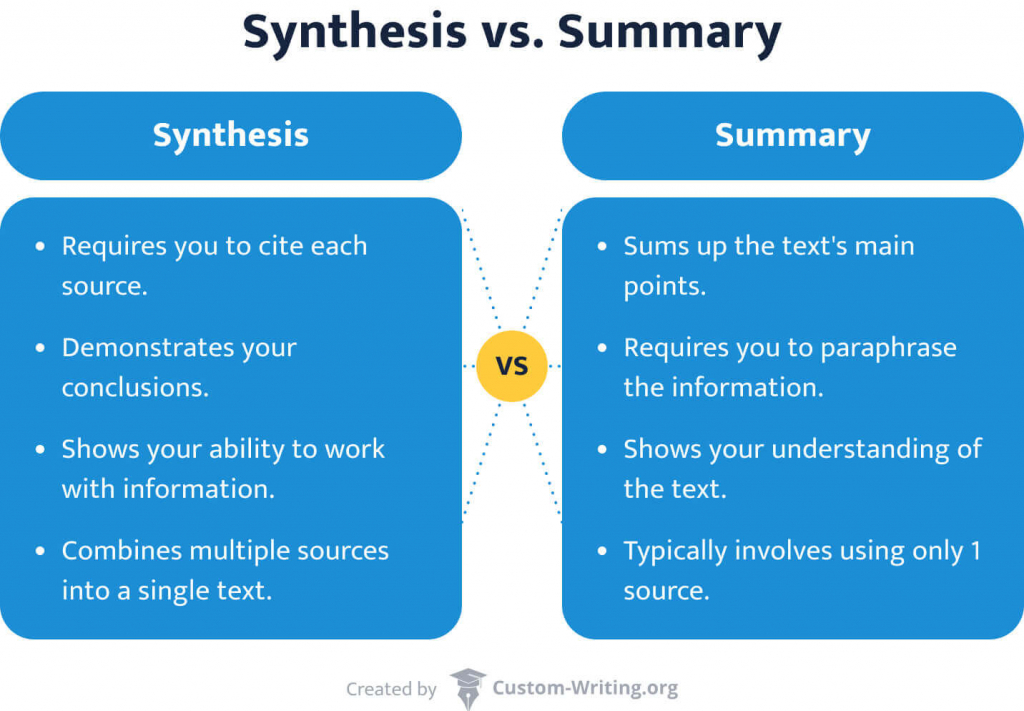
Both of these techniques are used for the synthesis essay:
- The summary goes in the conclusion. You briefly sum up your paper’s main ideas.
- Synthesis goes in the body paragraphs. Here, you combine multiple sources to prove a point.
📝 Synthesis Essay Types
There are two main types of a synthesis essay: argument and explanatory synthesis.
Both of them require working with multiple reliable sources and analyzing information. The only difference is that an argument synthesis essay requires your own opinion, while an explanatory synthesis essay does not.
Argument Synthesis Essay: Outline and Definition
As you already know, an argument synthesis essay requires you to state your own opinion about the given topic and back it up with several reliable sources. The purpose of such an essay is to persuade the reader that your point is correct.
Here’s what an argument synthesis essay consists of:
Explanatory Synthesis Essay: Definition and How to Write
An explanatory informative synthesis essay requires you to stay neutral towards the problem you are discussing. This means you cannot express your own opinion considering the given question or a problem. Your task is just to inform the reader. That’s why this essay type is also called informative synthesis.
Check out this explanatory essay outline:
✅ How to Write a Synthesis Essay Step by Step
When it comes to the synthesis essay outline, it’s not too different from other assignments. Have a look at this template:
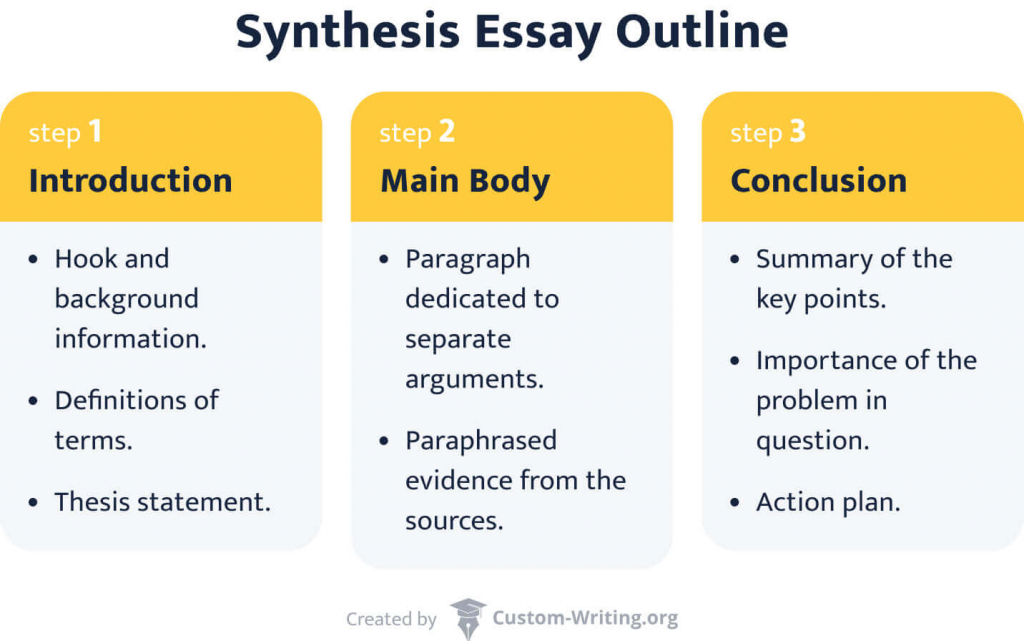
How to Synthesize: Working with Sources
After you’ve decided on your topic, it’s time to figure out how to synthesize articles into one text. This is how you do it:
- Choose reliable sources: the ones printed in journals or published on academic websites.
- Become familiar with them and see if they fit into your essay.
- Try to find a few sources for each point. It will increase your essay’s reliability.
- Relate each source to your arguments and see similarities between them.
- Don’t forget to list every source in the references.
When you are done with a comprehensive analysis of related literature, try to step back and imagine a person who has a different opinion on this topic. Think of some arguments that they can provide to prove their opinion. After you have the list of arguments, find the written evidence of why they are wrong and put them in your essay.
Analyzing and organizing sources is the first and very important step for the synthesis essay. So make sure you do understand what the text means before using it as a reference.
Synthesis Essay Outline: How to Write
For structuring your essay, it’s useful to try mapping . This technique means combining the information from different sources and rearranging it to create a new direction. To do it, you need to analyze the authors’ ideas and come up with your own conclusions.
The best way to do that is called synthesis matrix or graphic organizer. It’s a chart that you can make when you start working on your essay. Here you have a horizontal column that states the main ideas and a few vertical columns that present sources. Your task is to take sources you have chosen and write down the main ideas from them.
Here’s an example of a matrix chart:
While doing that, you will see how many sources contain the same ideas. When you analyze them, you will be able to formulate your thesis backed up with evidence. The synthesis matrix also helps to see new arguments you can cover in your synthesis paper.
How to Write an Introduction for a Synthesis Essay
Now it’s time to start writing the paper. In the introductory part of the essay, you can include:
- A short yet catchy sentence or a quotation that would present the topic. The start of your essay should make people interested. It’s best to make the first sentence not only informative but also easy to understand.
- The texts that are used for the essay. Provide the titles and the authors’ names (use the appropriate guidelines depending on the writing style.)
- The background information which is needed to understand your essay. Definitions of terms or unknown words considering the topic can be included in this part. Otherwise, people may find it hard to understand what they are reading about.
How to Write a Thesis for a Synthesis Essay
A thesis statement is a point of view on a certain problem that you will defend in your essay. It should contain the key points that you want to include in your paper. Here’s how to create a perfect thesis statement:
- Find several central ideas in the chart.
- Choose the ones that are repeated the most often and the ones that you feel need to be in your essay.
- Combine them, and you have a thesis statement with all the key points.
- Make a draft of the thesis statement. Try to formulate the main idea you want to present in your essay.
- Elaborate on this idea. Add some details and expand it a bit further.
If the whole picture is coherent, and it conveys exactly what you wanted, then this is your perfect thesis statement. See the example below:
Gender inequality still exists at the workplace: women are less likely to get the most responsible positions, easily lose careers due to maternity leave, and often receive less pay for the same amount of work.
How to Write Synthesis Paragraphs for the Main Body
Your essay’s main body consists of a few paragraphs. Each of them presents a different argument considering the topic. When you start a paragraph, make sure to begin with a topic sentence, which informs the reader about the paragraph’s main idea. Then, include the synthesized sources and elaborate on them.
Here’s what you should and shouldn’t do when writing the main body:
You can use the following words to present the ideas from your sources. They will help you reflect the authors’ tone:
How to Conclude a Synthesis Essay
There are quite a few ways to conclude the synthesis paper. Have a look at some of the options:
- Paraphrase the thesis. As you remember, the thesis is the main idea of your essay. The conclusion is a good place to remind your readers about it. When they are done with the reading, they remember the most important thing from your essay.
- Synthesize the arguments. There is no need to repeat everything you wrote in your essay. Just briefly summarize the most crucial points.
- Answer the “So what” question. Tell the readers why this topic matters, why you’ve chosen it, and why it’s valuable for the reader.
- Provide a closure. It’s an effective strategy when you want to make the reader think. Leave them with a strong statement at the end of your essay.
Synthesis Paper Proofreading Tips
When you have finally written your paper, there is still one important thing left to do. You need to check your paper for any grammatical and contextual mistakes. You certainly can do it yourself, but it would be perfect if you could ask somebody else to read it.
The first thing you need to check grammar-wise is the tense you are using. There is no single tense you need to use for the synthesis essay. It depends on the format:
- If you’re writing in MLA format, use the present tense;
- For APA essays, you use the past tense.
The next step is to check whether your synthesis essay has everything that’s required. For that, we have prepared the checklist of questions you can ask yourself to proofread your essays.
- Is there a clear thesis statement?
- Did you include all of the key points from the synthesis?
- Are there clear transitions between paragraphs?
- Did you organize a paragraph around a single idea?
- Did you use reliable and up-to-date sources?
- Did you analyze sources rather than just summarize them?
- Did you mention every source you’ve used?
If you’ve answered “yes” to all the questions—congratulations, you are done with the essay! Otherwise, you need to come back and fix everything that you’ve answered “no” to.
✍️ Synthesis Essay Topics and Prompts
Sometimes, when you don’t have a topic , it is tough to come up with a suitable idea. That is why we have prepared two lists of topics that you can use for any synthesis essay type.
Explanatory Synthesis Essay Topics
The topics below are suitable for an explanatory synthesis essay:
- The beginning of Hollywood cinema . Cinema is a huge industry in the USA. Tell the readers about its history. Describe what it was like in the beginning, which movie was the first one, and who started this industry.
- Tactics on dealing with noisy children. Sometimes kids can be very loud, especially in public places. Write about different tactics that can help with this issue.
- The effects of climate change on the water cycle. Climate change has affected the water cycle significantly. Your task is to explain how.
- The best American cities to live in. Provide the list of the best cities and explain why you’ve included them.
- The importance of a healthy diet . Keeping a healthy diet is beneficial in many ways. Write about all the advantages it brings.
- Who can become an entrepreneur? Entrepreneurship is not for everybody. In this essay, you can describe the qualities needed for having your own business.
- The correlation between overpopulation and poverty . Describe how overpopulation leads to poverty and vice versa.
- The advantages of taking an active vacation.
- Cultural shock as a part of moving to a different country.
- The consequences of the first wave of feminism.
- Synthesis of Tan and Rodriguez’ essays ideas.
- Difficulties you may encounter during the job interview.
- How does reading prevent Alzheimer’s disease?
- The effect of the COVID-19 pandemic on businesses.
- The connection between religion and politics in ruling the country.
- What can non-verbal signals tell you about a person?
- The psychology of leadership .
- The origins of the most common stereotypes about Americans.
- Role of social media in business communication.
- The synthesis of personal nursing philosophy concept.
- Behavioral components of schizophrenia and psychosis.
- Main components of successful entrepreneurship.
- Critical components of scientific research.
- Change in religion and human beliefs throughout history.
- The effect of global warming on modern life.
Argument Synthesis Paper Topics
The list of topics for the Argument Synthesis Essay:
- Vaping is better than smoking. People are starting to exchange cigarettes for vapes and e-cigarettes. In what ways are they less harmful?
- Rich people should pay higher taxes. The same percentage of money doesn’t equal for rich and poor people. Explain why the ones who can afford more should share with others.
- Depression is a disease. Prove that psychological problems must be recognized as real health issues that should be cured and not ignored.
- Social media affects young people’s lives. Social media has a massive influence on people. In this essay, you can discuss which life spheres are the most affected.
- Beauty pageants should be banned. Provide the reasons why they should be banned and tell the reader about psychological problems they can cause.
- People should cut meat from their diet to stop global warming. Describe how the meat industry influences climate change.
- The voting age should be 25+. Your task is to show the reasons why the votes of people under 25 should not be taken into account during elections.
- A healthy lifestyle requires a lot of money.
- Each healthy man should serve in the military.
- School bullying should be punished by immediate exclusion.
- Does friendship exist between men and women?
- Drinking coffee is a bad habit.
- Working hard is more important than being talented.
- Everybody should visit a therapist at least once.
- Should universities be free?
- Artificial intelligence will cause huge unemployment rates.
- Gaming should not be allowed to children under 18.
- Components and strategies of social responsibility
- Integration of relevant ethical theory and conceptual principles in health care
- Children under 10 should be banned from gadgets .
- Social media platforms facilitate cyberbullying.
- Issues of distance education.
- Social media addiction is a serious disease.
- Deforestation critically contributes to global warming.
- Healthcare should be free for everyone.
📑 Synthesis Essay Example & Synthesis Essay Format Tips
Now let’s talk about formatting. There are two writing styles you can use for a synthesis essay: APA or MLA. You need to choose the one that is required for your assignment.
We will start with the paper in APA format. It is usually used in science and education.
And these are MLA formatting rules:
Finally, we’ve prepared a synthesis essay sample for you to check out. Feel free to download the PDF file below:
First introduced in the Civil Rights Act of 1964, affirmative action policies aim to mitigate the discrepancy in opportunities available for underrepresented social groups by taking into account one’s minority background. The policies have become a pressing public issue that obstructs previously marginalized individuals, particularly in the educational environment.
Thank you for reading the ultimate guide on synthesis essay writing. We hope you found it helpful. Don’t forget to share it with your friends. Good luck with your assignments!
🔍 References
- Writing a Synthesis Essay: Bowling Green State University
- What Is Synthesis: University of Manitoba
- Synthesis: Biology Online
- Reading Strategies: Difference Summarizing and Synthesizing: WordPress
- Summary, Analysis, Synthesis Definitions: University of Utah
- Argumentative Synthesis: University of Arkansas
- How to Synthesize Written Information: Simply Psychology
- Mapping of Synthesis Essay: University of Nevada, Reno
- Writing a Literature Review and Using a Synthesis Matrix: Florida International University
- Synthesis Essay: Cleveland State University
- Literature Review: Synthesizing Multiple Sources: Louisiana State University
- Writing a Conclusion: Texas Women’s University
- General APA Guidelines: Purdue University
- Share to Facebook
- Share to Twitter
- Share to LinkedIn
- Share to email

Do you know how to make your essay stand out? One of the easiest ways is to start your introduction with a catchy hook. A hook is a phrase or a sentence that helps to grab the reader’s attention. After reading this article by Custom-Writing.org, you will be able to...

A critical analysis essay is an academic paper that requires a thorough examination of theoretical concepts and ideas. It includes a comparison of facts, differentiation between evidence and argument, and identification of biases. Crafting a good paper can be a daunting experience, but it will be much easier if you...

Critical thinking is the process of evaluating and analyzing information. People who use it in everyday life are open to different opinions. They rely on reason and logic when making conclusions about certain issues. A critical thinking essay shows how your thoughts change as you research your topic. This type...

Process analysis is an explanation of how something works or happens. Want to know more? Read the following article prepared by our custom writing specialists and learn about: process analysis and its typesa process analysis outline tipsfree examples and other tips that might be helpful for your college assignment So,...

A visual analysis essay is an academic paper type that history and art students often deal with. It consists of a detailed description of an image or object. It can also include an interpretation or an argument that is supported by visual evidence. In this article, our custom writing experts...

Want to know how to write a reflection paper for college or school? To do that, you need to connect your personal experiences with theoretical knowledge. Usually, students are asked to reflect on a documentary, a text, or their experience. Sometimes one needs to write a paper about a lesson...

A character analysis is an examination of the personalities and actions of protagonists and antagonists that make up a story. It discusses their role in the story, evaluates their traits, and looks at their conflicts and experiences. You might need to write this assignment in school or college. Like any...
![synthesis and reflection essay example Critical Writing: Examples & Brilliant Tips [2024]](https://custom-writing.org/blog/wp-content/uploads/2021/02/fingers-note-report-journalist-filling-284x153.jpg)
Any critique is nothing more than critical analysis, and the word “analysis” does not have a negative meaning. Critical writing relies on objective evaluations of or a response to an author’s creation. As such, they can be either positive or negative, as the work deserves. To write a critique, you...

If you are assigned to write a rhetorical analysis essay, you have one significant advantage. You can choose a text from an almost infinite number of resources. The most important thing is that you analyze the statement addressed to an audience. The task of a rhetorical analysis essay is to...

Any literary analysis is a challenging task since literature includes many elements that can be interpreted differently. However, a stylistic analysis of all the figurative language the poets use may seem even harder. You may never realize what the author actually meant and how to comment on it! While analyzing...

As a student, you may be asked to write a book review. Unlike an argumentative essay, a book review is an opportunity to convey the central theme of a story while offering a new perspective on the author’s ideas. Knowing how to create a well-organized and coherent review, however, is...

The difference between an argumentative and persuasive essay isn’t always clear. If you’re struggling with either style for your next assignment, don’t worry. The following will clarify everything you need to know so you can write with confidence. First, we define the primary objectives of argumentative vs. persuasive writing. We...
- Our Writers
- How to Order
- Assignment Writing Service
- Report Writing Service
- Buy Coursework
- Dissertation Writing Service
- Research Paper Writing Service
- All Essay Services
- Buy Research Paper
- Buy Term Paper
- Buy Dissertation
- Buy Case study
- Buy Presentation
- Buy Personal statement
Synthesis Essay Writing
Synthesis Essay Examples
13+ Winning Synthesis Essay Examples For Your Inspiration
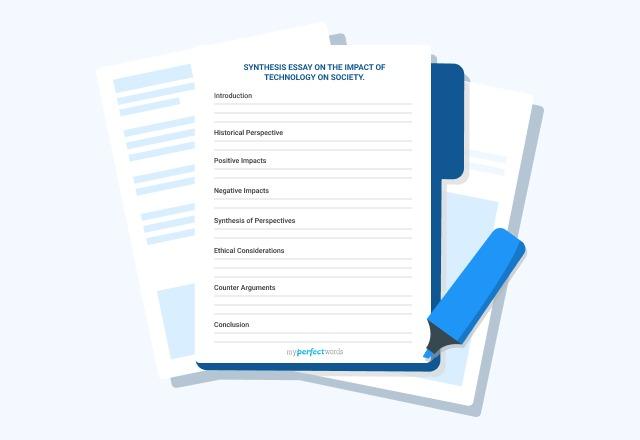
People also read
Learn How to Write a Synthesis Essay Step by Step
Best Synthesis Essay Topics and Prompt Ideas
Synthesis Essay Outline - Template and Examples
Are you struggling to make sense of synthesis essays, unsure where to begin, or how to enhance your writing?
Many students face the challenge of feeling overwhelmed when trying to blend diverse ideas and sources seamlessly. It can be challenging to create a cohesive piece that draws from various perspectives.
But fear not!
In this blog, we will provide you with winning synthesis essay examples and valuable insights to enhance your essay writing skills.
So, let’s get started.
- 1. Understanding What A Synthesis Essay Is
- 2. Synthesis Essay Examples
- 3. Synthesis Essay Topics - Examples
- 4. Tips for Writing an Effective Synthesis Essay
Understanding What A Synthesis Essay Is
A synthesis essay is a special kind of academic writing where writers blend ideas and information from various sources to create a clear and organized argument.
Unlike other types of essays , a synthesis essay demands the integration of various perspectives to form a new understanding or insight.
It involves critically examining different sources, and synthesizing them to develop a comprehensive viewpoint on a particular topic.
Looking at synthesis essay examples can really help you write a great essay. Here's an example of a synthesis essay to inspire you in your own writing:
Synthesis Essay Outline Example
An outline is just like a table of content sections on a page. It consists of categories and subcategories of a given topic that the writer plans to cover in the essay. Below is a synthesis essay outline template that explains the synthesis essay outline in detail. Have a look at it.
Thesis For Synthesis Essay Example

Tough Essay Due? Hire Tough Writers!
How to Write a Synthesis Essay - Example
In order to write a good synthesis paper, you need to follow the format and proper procedure. The synthesis essay has an introduction paragraph, three body paragraphs with supportive evidence to back up the topic, and a thesis statement.
And a conclusion paragraph where you answer all the questions while referring back to the main thesis.
Check out this sample template; it will help you learn the basics of synthesis essay structure.
AP English Language and Composition Synthesis Essay Example
The ap lang synthesis essay requires students to analyze information from various sources to discuss the topic of their essay. Refer to the sample AP language synthesis essay to learn how you can write a perfect synthesis essay.
Synthesis Essay Example Ap Lang
2022 Ap Lang Synthesis Essay Example
Synthesis Essay Examples for Different Formats
Knowing how to write synthesis essays in different styles is important. Given below are some examples of synthesis essays in different formats.
APA Format Synthesis Essay Example
APA (American Psychological Association) is a citation style that provides formatting conventions for student and professional papers. Below is a sample example of an APA-style synthesis essay.
MLA Format Synthesis Essay Example
MLA (Modern Language Association) is another referencing style that allows us to cite the sources in a proper format. Here is an MLA-style synthesis essay example to help you learn the basics of this style.
Different Types of Synthesis Essay Examples
Synthesis essays come in various types, each requiring a unique approach. Explore the following synthesis essay examples tailored to different types, offering a comprehensive overview of how to tackle diverse writing tasks:
College Synthesis Essay Example
This sample PDF is to help the college students to learn the outline, format, and structure of the synthesis essay. You can easily download it and save it with you for further usage.
Explanatory Synthesis Essay Example
The explanatory synthesis is intended to explain a particular subject in detail to make it easy to understand for people. Refer to the sample essay given below and see what makes it different from a simple synthesis essay.
Argumentative Synthesis Essay Example
The argumentative synthesis is another type of synthesis essay that is intended to present an argument. The writer presents his claim and supports it with facts and evidence to prove it right. Check out the sample essay given below to understand how it is different from a general argumentative essay.
Eminent Domain Synthesis Essay Example
An eminent domain synthesis essay explores the concept of eminent domain, which is the government's authority to take private property for public use. This type of synthesis essay delves into various aspects of eminent domain, considering legal, ethical, and social perspectives.
Here’s an example:
Synthesis Essay Example About Social Media
This type of synthesis essay explores the impact of social media on individuals and society. It aims to analyze and synthesize information to construct a well-rounded understanding of the role of social media in our lives. Here’s an example of it:
Synthesis Essay Topics - Examples
Choosing a compelling topic is crucial when writing a synthesis essay. Here are some thought-provoking synthesis essay topics that can inspire your writing:
- The Impact of Technology on Human Interaction
- Climate Change and Global Sustainability
- The Role of Social Media in Modern Society
- The Intersection of Artificial Intelligence and Ethics
- Education Reform: Challenges and Opportunities
- Impact of Social Movements on Policy Change
- Healthcare Access: A Global Perspective
- Cultural Diversity in the Workplace
- The Influence of Literature on Society
- The Future of Work: Remote vs. Traditional
Looking for more topics? Check out this blog on synthesis essay topics for inspiration.
Paper Due? Why Suffer? That's our Job!
Tips for Writing an Effective Synthesis Essay
Crafting a compelling synthesis essay goes beyond the writing process; it requires strategic planning and meticulous execution. Here are key tips to ensure your synthesis essay stands out:
- Select Credible Sources
Begin by choosing reliable and credible sources. Ensure that the information you gather is from reputable authors, organizations, or publications to strengthen the foundation of your essay.
- Background Information is Key
Provide sufficient background information on your chosen topic. Help your readers understand the context and significance of the subject matter before delving into your argument.
- Develop a Coherent Argument
Focus on building a clear and coherent argument throughout your essay. Ensure that each paragraph contributes to the overall flow and supports your thesis effectively.
- Support Your with Evidence
A strong synthesis essay requires a well-supported argument. Back up your claims with evidence from your chosen sources, demonstrating a thorough understanding of the topic.
- Utilize Sources to Support Each Other
Instead of treating sources in isolation, highlight their relationships. Demonstrate how each source complements or contrasts with others, emphasizing the interconnectedness of your information.
- Synthesis Essay Requires Critical Analysis
Go beyond summarizing your sources; engage in critical analysis. Evaluate the strengths and weaknesses of each source and consider their implications for your argument.
- Ensure a Supported Argument:
Throughout your essay, consistently reinforce your central argument. Every piece of information should contribute to and reinforce the main thesis, creating a cohesive and persuasive narrative.
In conclusion , tackling synthesis essays is easier than it seems when armed with the right knowledge. Use the tips and examples provided to boost your skills and approach these essays with confidence.
But if you ever feel stuck, MyPerfectWords.com is here to help. Whether you are looking for an essay writing service for college or university our team of experts is just a click away. They ensure your essays not only meet standards but stand out for their clarity and depth.
Ready to elevate your writing? Hire our experts today!

Write Essay Within 60 Seconds!

Dr. Barbara is a highly experienced writer and author who holds a Ph.D. degree in public health from an Ivy League school. She has worked in the medical field for many years, conducting extensive research on various health topics. Her writing has been featured in several top-tier publications.

Paper Due? Why Suffer? That’s our Job!
Keep reading
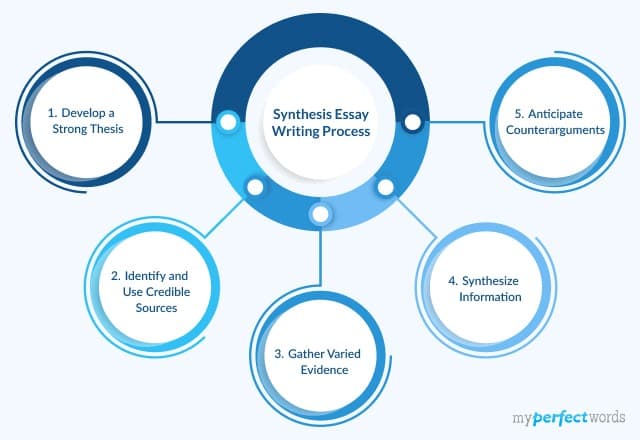
Synthesizing
Synthesis essay sample.
Below is a student sample of a synthesis essay. To see this document in appropriate MLA format, choose this link : Synthesis-Essay-Sample1
Student Name
Writing 102
17 February 2016
The New Meaning of Family
“Cam, we are just a new type of family, they don’t have the right vocabulary for us yet. They need one of us to be the mom”
-Jesse Tyler Ferguson, Modern Family
In recent years, researchers who study family dynamics have discovered that the American family is constantly changing. Stephanie Cootnz, an award-winning writer and teacher of family studies reflects on the 1950s in her essay, “What We Really Miss About the 1950s”, and gives an in-depth analysis of why it was easier to achieve the “nuclear family” structure back then. Now that we are in the 21st century, American families are faced with many new realities. Natalie Angier, a science journalist for The New York Times and Pulitzer Prize winner, analyzes these different realities and the constant remodeling of our society’s definition of family in her NY Times article, “The Changing American Family”. Angier uses modern day profiles of families in her article to show recent trends such as same- sex marriage and cohabitation that reinforce Cootnz’s idea that families are always in flux and having to play catch-up with a changing world.
In her essay, Stephanie Cootnz describes the 1950s as the time when, “America was on a dramatically different trajectory that it had been in the past… [a path] that had already taken people to better places than they had ever seen before and would certainly take their children even further” (35). She uses an academic tone to convey both the negatives and positives of the 1950s to the reader. The United States had just recovered from the Great Depression and then just began to reestablish itself from World War II. The 1950s were a time of great hope. This renewed confidence in the country and government allowed for Americans to focus on a new start and establish new values for their families. Cootnz points out that during this decade there was a lot of predictability and order. Cootnz writes that modern day parents, “associate the 1950s with a yearning they feel for a time when there were fewer complicated choices for kids or parents to grapple with… there was a coherent “moral order” in their community to serve as a reference point for family norms” (28). Throughout her essay, Cootnz builds her claims with the heavy use of statistics. She also uses anecdotes from research that she has conducted, which are reflections of the 1950s from people who lived through them, including her. Although they are opinions, they are used for the reader to have firsthand accounts of the era. She takes her readers down memory lane, especially those who lived in the 1950s, by discussing the importance of TV sitcoms back then. Shows such as Leave it to Beaver and Ozzie and Harriet, constantly promoted the new idea of a nuclear family. However, Cootnz reminds us that these shows did not reflect the real-life experiences of most American families, but rather showed them how they were suppose to live (33).
Of course there is some nostalgia for the 1950s. However, Cootnz argues that too much nostalgia can be blinding. Those who pick the 1950s as the best decade often end up saying, “”that it’s not the family arrangements in and of themselves they want to revive… they don’t miss they way that women were treated ” (Cootnz 29). It is often forgotten how the nuclear family back then served as a distraction for many social anxieties and ills such as the nuclear age, cold war, and racism. Cootnz ends her essay, with the claim the new economic reality in the two decades following the 1950s, caused a change in attitude towards the concept of family.
Natalie Angier essay strengthens Cootnz’s thought that the 1950s’ idea of a nuclear family is a concept that is in our past and with the new realities of the 21st century, it is impossible to reinvent it. She says, “families are more ethnically, racially, religiously, and stylistically diverse than half a generation ago” (Angier). Her article, “The Changing America”, is a clear reflection of the reality we live in today. The article is composed of different sections that focus on one of these trends; same sex marriage, cohabitation, immigration, and families with incarcerated members. Angier discusses modern day trends, which means that unlike Cootnz, she does not have history to serve as a foundation of her claims. Therefore she must resort to using present day situations to confirm her ideas. The tone of the article is much less academic than Cootnz. It contains a more balanced mixture of statistics and commentary from the different families. By incorporating profiles of different family arrangements, Angier makes the article relatable to everyone. The use of present-day statistics, interwoven with quotes from family members she interviewed, validates Angier’s ideas on the reality of modern family dynamics. The numbers of cohabitating couples for example are continuously on the rise. Angier notes, “From 1996 to 2012, the number jumped almost 170% percent, to 7 million from 2.9 million” (Angier). Statistics like these become a real life scenario to the reader, when they read the story of Ana Perez, a mother of 3 from New York who lives with the father of her third child. In her article, Angier captures the new definition of family onto a piece of paper.
After reading both of my sources it is clear to me that the image of the nuclear family is nearly impossible to obtain. In our culture, the concept of family will always be a necessity. But one thing that we need to realize is that the definition of family will always continue to evolve. We still hold onto the 1950s’ idea of family because it reflects of time a great optimism and stability. “The experience of shared sacrifices in the Depression and war, reinforced by a New Deal- inspired belief in the ability of government to make life better… this general optimism affected people’s experience and assessment of family life” (Cootnz 36). In a sense, we are still seeking for a similar sense of hope today. If we idealized the ways of the past too much, it prevents us from seeing the changes and problems happening around us today. Women are far more involved in the paid labor force today than in the 1950s and the idea of marriage has been put on the back burner for many couples. These new realities of our society contradict many of the idealized concepts of family that have developed over the years. However, we must accept that these idealized concepts no longer fit into our society and begin to try to understand what the term family is becoming.
With each new generation comes with a new set of problems and a new set of solutions. It is evident after reading Natalie Angier’s article that there is much more flexibility to the concept of families today than there was in the 1950s. There is not a rigid and narrow definition that families must conform to fit the “norm.” What works for a family in one cultural and economic setting, might not work for another.
For example, the Schulte-Wayser family, a gay couple with 4 adopted children, could not be more different than the Indrakrishnan family, an immigrant family from Sri Lanka. The Schulte-Wayser family represents a new take on family arrangement, a mixture of modern and traditional values. The Indrakrishnan family embodies a lot of traditional family ties, even though they are from a far different culture. Angier points out, “Today the best place to find a traditional, G-rated American Family may be in an immigrant community… [Asian-American families] are half as likely to be divorced and only 16 percent of infants are born out of wedlock, compared to 41 percent over all” (Angier).
The evolution of the American family is something that we can’t control. Just as Cootnz reminds us that family dynamics underwent a change from the 1950s to the 1970s (Cootnz 42-43), our ideas of modern family dynamics will also change 20 years from now. The changes in families amongst different generations reflect how much better they want to be than the previous generation.
It is impossible in today’s world to label a family as “typical” or “normal”. Just as the 1950s sitcoms served to demonstrate that time period’s version of family, 21st century TV shows, such as Modern Family, are doing the same. There are varieties of forms that families come in today. Not one type family is certain to succeed and another type is certain to fail. How a family is able to function internally is far more important than how it perceived from the outside. As I compare both Stephanie Cootnz essay with Natalie Angier’s article, I can say that family values and structure have definitely changed, but the value of family has not.
Works Cited
Angier, Natalie. “The Changing American Family.” The New York Times . 26 November 2013. Web. 16 February 2016.
Coontz, Stephanie. “What We Really Miss About the 1950s.” Rereading America: Cultural Context for Critical Thinking and Writing . 9th ed. Eds. Gary Colombo, Robert Cullen, and Bonnie Lisle. Boston: Bedford/St. Martin’s, 2013. 27-43. Print.
- Student Synthesis Sample, University of Mississippi. Authored by : Anonymous. License : CC BY-SA: Attribution-ShareAlike

- Schools & departments

Structure of academic reflections
Guidance on the structure of academic reflections.
Academic reflections or reflective writing completed for assessment often require a clear structure. Contrary to some people’s belief, reflection is not just a personal diary talking about your day and your feelings.
Both the language and the structure are important for academic reflective writing. For the structure you want to mirror an academic essay closely. You want an introduction, a main body, and a conclusion.
Academic reflection will require you to both describe the context, analyse it, and make conclusions. However, there is not one set of rules for the proportion of your reflection that should be spent describing the context, and what proportion should be spent on analysing and concluding. That being said, as learning tends to happen when analysing and synthesising rather than describing, a good rule of thumb is to describe just enough such that the reader understands your context.
Example structure for academic reflections
Below is an example of how you might structure an academic reflection if you were given no other guidance and what each section might contain. Remember this is only a suggestion and you must consider what is appropriate for the task at hand and for you yourself.

Introduction
Identifies and introduces your experience or learning
- This can be a critical incident
- This can be the reflective prompt you were given
- A particular learning you have gained
When structuring your academic reflections it might make sense to start with what you have learned and then use the main body to evidence that learning, using specific experiences and events. Alternatively, start with the event and build up your argument. This is a question of personal preference – if you aren’t given explicit guidance you can ask the assessor if they have a preference, however both can work.
Highlights why it was important
- This can be suggesting why this event was important for the learning you gained
- This can be why the learning you gained will benefit you or why you appreciate it in your context
You might find that it is not natural to highlight the importance of an event before you have developed your argument for what you gained from it. It can be okay not to explicitly state the importance in the introduction, but leave it to develop throughout your reflection.
Outline key themes that will appear in the reflection (optional – but particularly relevant when answering a reflective prompt or essay)
- This can be an introduction to your argument, introducing the elements that you will explore, or that builds to the learning you have already gained.
This might not make sense if you are reflecting on a particular experience, but is extremely valuable if you are answering a reflective prompt or writing an essay that includes multiple learning points. A type of prompt or question that could particularly benefit from this would be ‘Reflect on how the skills and theory within this course have helped you meet the benchmark statements of your degree’
It can be helpful to explore one theme/learning per paragraph.
Explore experiences
- You should highlight and explore the experience you introduced in the introduction
- If you are building toward answering a reflective prompt, explore each relevant experience.
As reflection is centred around an individual’s personal experience, it is very important to make experiences a main component of reflection. This does not mean that the majority of the reflective piece should be on describing an event – in fact you should only describe enough such that the reader can follow your analysis.
Analyse and synthesise
- You should analyse each of your experiences and from them synthesise new learning
Depending on the requirements of the assessment, you may need to use theoretical literature in your analysis. Theoretical literature is a part of perspective taking which is relevant for reflection, and will happen as a part of your analysis.
Restate or state your learning
- Make a conclusion based on your analysis and synthesis.
- If you have many themes in your reflection, it can be helpful to restate them here.
Plan for the future
- Highlight and discuss how your new-found learnings will influence your future practice
Answer the question or prompt (if applicable)
- If you are answering an essay question or reflective prompt, make sure that your conclusion provides a succinct response using your main body as evidence.
Using a reflective model to structure academic reflections
You might recognise that most reflective models mirror this structure; that is why a lot of the reflective models can be really useful to structure reflective assignments. Models are naturally structured to focus on a single experience – if the assignment requires you to focus on multiple experiences, it can be helpful to simply repeat each step of a model for each experience.
One difference between the structure of reflective writing and the structure of models is that sometimes you may choose to present your learning in the introduction of a piece of writing, whereas models (given that they support working through the reflective process) will have learning appearing at later stages.
However, generally structuring a piece of academic writing around a reflective model will ensure that it involves the correct components, reads coherently and logically, as well as having an appropriate structure.
Reflective journals/diaries/blogs and other pieces of assessed reflection
The example structure above works particularly well for formal assignments such as reflective essays and reports. Reflective journal/blogs and other pieces of assessed reflections tend to be less formal both in language and structure, however you can easily adapt the structure for journals and other reflective assignments if you find that helpful.
That is, if you are asked to produce a reflective journal with multiple entries it will most often (always check with the person who issued the assignment) be a successful journal if each entry mirrors the structure above and the language highlighted in the section on academic language. However, often you can be less concerned with form when producing reflective journals/diaries.
When producing reflective journals, it is often okay to include your original reflection as long as you are comfortable with sharing the content with others, and that the information included is not too personal for an assessor to read.
Developed from:
Ryan, M., 2011. Improving reflective writing in higher education: a social semiotic perspective. Teaching in Higher Education, 16(1), 99-111.
University of Portsmouth, Department for Curriculum and Quality Enhancement (date unavailable). Reflective Writing: a basic introduction [online]. Portsmouth: University of Portsmouth.
Queen Margaret University, Effective Learning Service (date unavailable). Reflection. [online]. Edinburgh: Queen Margaret University.
- SUBSCRIBE TO OUR NEWSLETTER

Home » Insights
Completing the Learning Loop: The Power of Synthesis and Reflection Prompts

by Jon Altbergs and Laurie Gagnon
At redesign, we encourage the adoption of a learning cycle that guides the learner through the habits and skills that support the development of competency with practice over time. in this post, we dig into the synthesis and reflection element of the learning cycle..
Let’s take a moment to revisit the two dimensions of the learning cycle. It represents the stages of meaningful learning that occur simultaneously during daily learning experiences (the “inner circle), and across multi-week units of study they constitute (the “outer circle”) that build toward authentic, competency-building work.

As our colleague Sydney Schaef explained in A Friendly Introduction to the Competency-based Learning Cycle ,
In a nutshell, the Competency-based Learning Cycle is a visual framework that illustrates the cognitive and metacognitive processes that help learners develop competency with practice and feedback, as they work and learn in increasingly challenging contexts. …The “outer circle” represents the four major stages of a competency-based project or unit of study through which learners explore a compelling question or issue. …The “inner circle” structures daily learning experiences. … These learning experiences are purposefully and directly connected to the larger arc (outer circle), such that successful, recursive movement through this inner cycle enables progress through the four stages of the unit.
Ongoing synthesis and reflection anchor the learning cycle. Every learning experience, we believe, should culminate with synthesis and reflection questions. Why are synthesis and reflection questions so important to close the loop of a lesson or learning experience? They are essential because the information they provide:
- supports the provision of individualized feedback
- builds relationships through teacher attunement
- gauges student engagement
- offers insight into learners’ metacognition, the key to self-directed learning.
Ultimately, synthesis and reflection questions are a moment of pause to “lift the hood” on learners’ thinking.
Meaningful learning and assessment generate evidence of learning (as opposed to simply evidence of working). Synthesis and reflection help the learner situate new ideas into their overall understanding and helps the teacher gain insight into the thinking processes and conceptual understanding behind other work that the learner produces . When planning lessons, teachers often rightfully focus on designing assignments and activities that prompt students to think critically about the content they are learning. But rigorous assignments are not enough. Students need opportunities to synthesize and reflect on their learning. Synthesis connects the day’s learning to prior learning, helping students build schema and deepen their understanding. Reflection encourages metacognitive development by shifting the focus from the what of learning to the how.
A synthesis prompt asks students to identify the important learning, summarize the learning, and articulate connections between the new learning and prior learning, knowledge, or experience in order to create or deepen understanding . Well-crafted synthesis questions lay the foundation for transferability of skills and knowledge. By incorporating synthesis into daily practice, building the connections that expand schema and ensure transferability is an ongoing process, rather than one that occurs at the end of a unit, the end of the year, or when new material is introduced.
Synthesizing, like other strategies and skills, is a capability that develops over time and should be explicitly taught . Responding to a synthesis prompt calls upon three specific elements: determining importance, summarizing, and connecting. First, students identify the important parts of their learning, the key takeaways from the lesson or learning experience that were essential to completing the task at hand. Second, students summarize by concisely communicating the what and the why of their learning—the key content and its importance. Finally, when students synthesize they connect the day’s learning to a larger context, such as prior learning, the essential question, or their own experience and describe how connecting the two deepens their understanding. Connections can also be made to novel situations to extend thinking.
Ultimately, the purpose of synthesis questions is the production, rather than reproduction, of knowledge . When students begin to explore a specific topic, their pool of knowledge may be limited, making rich connections and synthesis more difficult, but as they have more to call upon, those new (to them) insights happen more often.
Though the thinking underlying synthesis prompts is complex, the prompts themselves don’t have to be. I used to think … but then I learned … and so now is a simple frame for synthesis. As part of an exit ticket, journaling prompt, or classroom discussion, this frame incorporates all three elements and creates the opportunity to uncover what students know and what gaps and misconceptions need to be addressed.
A reflection prompt asks students to look critically at their learning process from its inception to its completion . Reflection incorporates summarizing, evaluating, and inferring. When reflecting, students describe the steps they took to complete a task, focusing on their strategic action—the strategies and skills they used and the adjustments they made on their way toward their learning goal. They then make inferences about the influence of their actions on their outcomes to evaluate the effectiveness of those actions. Reflection is vital to fostering agency, self-efficacy, and independence, as it aids in building self-regulated learning skills: the ability to set goals and appraise tasks; monitor one’s learning progress; apply strategies as needed; and sustain motivation.
Reflection helps the learner to evaluate whether their approach to their learning was successful and to surface lessons about how they learn, which can help them in being successful in their next learning endeavor.
- What was my learning goal? Did I achieve my learning goal?
- How did I learn what I learned?
- What worked well as I learned? How do I know it worked well? What did not work as well as I wanted? How do I know it didn’t work well?
- What changes did I make on the fly? What was the effect of those changes?
- What did I learn about myself as a learner? How will this insight help me learn in the future?
- How did my thinking change as a result of my new learning?
- How can I use my new learning in the future?
If you are new to the idea of synthesis and reflection as a regular part of the learning process or if you want to bring more intention to how you craft questions, check out this self-assessment checklist for Synthesis & Reflection Prompt Design . To see it in action, check out this personal narrative unit outline that illustrates how the reflection and synthesis prompts at each key stage of the unit build in complexity as learners move through the stages of the learning cycle: making meaning, investigating, creating, and finally, presenting, celebrating, and reflecting.
Back in the spring, our first tip for meaningful learning in COVID was to FOCUS ON EVIDENCE OF LEARNING (not evidence of working). Reflecting back, focusing on evidence of learning is actually a fundamental practice for learning. Now that schools and districts are getting back to school after the emergency learning situation of the spring, but still in very different conditions than before, we have the opportunity to design learning experiences that better incorporate key ideas from the research on how we learn.
If you’re interested in hands-on learning and support to help you design learning experiences that are research-based and built around the learning cycle, check out this upcoming workshop series, The Learning Cycle Workshop , offered through reDesign’s Institute in October/November. We hope to see you there!
Join the community!
Sign up to receive our newsletter, access best-of educational resources, and stay in the know on upcoming events and learning opportunities. We hope to see you soon!
Share this Post
Sydney Schaef
More Posts by this Author
Related Insights

3 Takeaways From Competency-Based Design Research
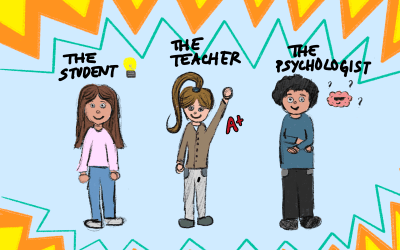
Insights from a Youth Participant at SXSW

Igniting Curiosity
Explore our educator resources.
Check out reDesign’s curated collection of tools, resources, and guides to support educators in learner-centered communities. We’ve got learning activities, performance assessments, competency-based implementation tools, and formative tasks for learners of all ages!
South Shore took a professional learning community approach to refining and implementing a range of school-wide shifts, designed to make grading more fair, accurate, and helpful.The Fellow designated to lead this project served in an administrator role, and helped the school community coalesce around four areas for change: 1) developing a competency-based grade scale, 2) directly linking all assignments and grades to standards; 3) instituting a universal late work policy; and 4) implementing a revision policy focused on relearning. Background knowledge-building, feasibility discussions that incorporated community input, and formalizing a plan for change were all part of the journey, with the recognition that the school would adjust the plan along the way. In Year 2, communication, transparency with all stakeholders, and continued education have been essential, as well as continued solicitation of feedback as assessments were developed that aligned with the rollout of the new grade scale. Ultimately, South Shore is not only rethinking grading – the school is also rethinking work habits, remediation, assessments, instruction, and curriculum.
The Melrose High School team identified 3 anchor questions: How can assessments best serve student learning? What do we want our students to leave with? How can students drive and discuss their learning? Guided by these, they developed an integrated approach to 21st century grading that fosters equity by: (1) Supporting students’ Habits of Learning, across the academic program (2) Increasing accuracy and transparency in grading; (3) Developing new policies for Retaking and Revising Assessments, and establishing a minimum grade of 50%; (4) Proactively communicating; (5) Explicitly nurturing student voice; and (6) Adopting universal design principles for efficient assessment-building within a flexible environment.
Revere High School identified three “rethinking” arenas: 1) Clarify what it means for students to be proficient; 2) Ensure alignment with standards and other frameworks; 3) Develop consistent practices for grade calculations, the use of rubrics, and grade reporting. The pilot team collaborated to design a prototype for a common grading table, category weights connected to power standards, and a plan to develop assessments tied to those standards-based learning targets. This approach sharpens the focus on student proficiency, takes gradebook construction out of the hands of teachers and considers every step of “the what” in a more comprehensive way.
Revere High School, Part 2 – Developing a Culture of Competency: 72% of the students who attend Revere High School are learning English. A number of them have struggled to pass the MCAS (state’ graduation exam), and have also experienced course failure. As an extension of their #RethinkingGrading efforts, the District is designing a customized and personalized graduation pathway, guided by a Profile of a Graduate. To ensure teachers can effectively support students, the district is partnering with reDesign to develop and facilitate professional learning experiences and modularized courses: a commitment to developing a culture of competency for both young people and the adults who serve them.
Synthesis Essay

Writing a Perfect Synthesis Essay: Definition & Examples
16 min read
Published on: Mar 1, 2023
Last updated on: Jan 31, 2024

People also read
Interesting Synthesis Essay Topics You Must Consider
Synthesis Essay Examples: Learn From Powerful Example
Share this article
Do you have a ton of research to synthesize but don't know how? Or maybe you're not sure what a synthesis essay is and how to write a good synthesis essay.
We know writing a synthesis essay is not an easy task to do; it’s challenging for most of us. But it can be perfectly done with the right guidance and preparation.
In this blog, we'll walk you through all the necessary information to craft a perfect synthesis essay. So you can get done with your assignments confidently!
Let’s get started.
On This Page On This Page -->
What is a Synthesis Essay?
Synthesis essay definition states:
It is a piece of writing that takes a unique perspective on a central idea, topic, or theme. Then backs it up with evidence from multiple sources.
A synthesis essay is an important part of academic writing. The main purpose of this essay is to show your ability to prove an argument.
To make sense of these arguments, you need to use different credible sources. It demonstrates your basic understanding of the main subject. This type of essay help to enhance your critical, analytical, and research skills.
A synthesis essay is made up of ideas and conclusions based on the information reviewed. Also, this essay asks you to summarize the topic and add your own thoughts about it in relation to what you have read.
Furthermore, the synthesis essays can be similar to analytical essays , argumentative essays , or compare and contrast essays .
Synthesis Essay Types
There are three types of a synthesis essay:
1. Argument Synthesis Essay
This essay's purpose is to debate or argue on a certain topic or issue. It justifies its claims by providing evidence in the body of the essay.
In contrast to the explanatory essay, you will perform the same thing as if you were writing a typical argumentative paper. First, state your argument, make supporting statements, and back up each claim with reliable facts.
2. Review Essay
A review essay is frequently written as a preparatory essay to an argument synthesis. Review essays are commonly used in social science and medicine classes.
It is a discussion of what has already been published on a topic, with a critical examination of the sources mentioned.
An unwritten thesis statement is added to it, which is not final and indicates that further study is needed in that area.
3. Explanatory Synthesis Essay
In this essay, the writer helps the reader to grasp deeper knowledge about the topic. Rather than arguing or debating on some points, the goal of this essay is to explain a certain topic.
Like any other essay, it needs backing up with supporting claims and credible sources.
How to Start a Synthesis Essay?
The following are some helpful techniques for writing an essay. These will help you start the process and avoid common errors that plague many writers.
1. Choosing a Synthesis Essay Topic
A prompt for a synthesis paper must be arguable. Based on your project, you may be required to select primary content. Select a book that may include contrasting perspectives. Here are some important tips for choosing a topic for a synthesis essay.
- Look through the themes and ideas. Read from sources and investigate specific topics thoroughly to see if any of them catch your interest.
- Select a topic and collect relevant and valuable references for your synthesis paper.
- Outline your synthesis essay using concepts or ideas from the sources. This should make writing a lot simpler and save you a lot of time.
It is necessary to find an arguable topic to make your synthesis essay effective. Another reason is that these topics have been discussed in public for decades.
Examples of good synthesis essay topics are;
- The process of hiring in the age of social media
- Social networks promote suicide
- Should higher education be free?
- Is it necessary to remove marks in education
- The importance of getting a good education
- 3D printers are not used efficiently nowadays.
- Is technology really helping people?
- Why has technology made surgery safe and effective?
- What is the cause of widespread obesity in teens?
- What is the role of gender today?
2. Analyze Your Topic
Here's how you can fully understand your synthesis essay topic.
- Grasp the Idea of a Synthesis Essay
A synthesis essay's purpose is to establish meaningful connections between sections of a work. When conducting research on a topic, you have to look for connections to build a strong viewpoint on the subject. The ultimate goal of the essay is to present and prove a claim about a topic .
- Select a Topic Appropriate for a Synthesis Essay
The subject and topic must be extensive enough to include multiple relevant sources. If you have a free hand in deciding what to write about, some preparatory research may assist you in researching and choosing the right topic.
- Select and Study Your Sources Carefully
Research and find relevant information and sources. Generally, choose at least three references for your essay. It's a good idea to learn one or two additional sources for better understanding but no matter what it is, make sure that you study it properly.
Remember that it is better to read three sources properly than five sources poorly.
Compile each source by writing notes in the margins. This allows you to keep track of your thoughts, fresh ideas, and so on.

Paper Due? Why Suffer? That's our Job!
- Reread the Source Material
Reread your source material for elements that will help to support your argument.
Examine your sources for important statements, figures, thoughts, and facts that support your thesis. Make a note of them when you come across them. This will be very useful throughout your writing process.
3. Develop a Thesis Statement
Your thesis statement will be the central idea of your essay. It should cover the topic and express your viewpoint on it. After reading the sources and conducting your research, form an opinion on your topic.
It should be stated as a complete sentence. Based on the essay, your thesis statement could be the first sentence of the essay or the last sentence of the first paragraph.
- Structure Your Thesis Statement Creatively
To present your thesis, use a more creative structure. You can use a more elaborate structure than the one outlined above. You can develop your essay using the following approaches:
Straw man: In this approach, you will present the counter-arguments first. Then demonstrate their weaknesses and flaws.
Such an approach demonstrates your awareness of the opposition as well as your readiness to respond to it. You present the counter-argument immediately following your thesis statement, followed by evidence to refute it. And conclude with a positive argument that supports your thesis.
Concession: In structure, concessions in essays are similar to the straw man. But this approach acknowledges the validity of the counter-argument while demonstrating that your argument is stronger. This structure is suitable for presenting papers to readers who hold opposing views.
Illustration/ Example: It could be a thorough narrative, synopsis, or quotation from your source material that provides support for your position. However, you should not make your paper a collection of examples at the expense of supporting your thesis statement.
Comparison and Contrast: In this approach, similarities and differences between two subjects or sources demonstrate both aspects. It requires a thorough reading of your source material to identify both subtle and major points of comparison.
This type of essay can present its arguments source by source or by points of similarity or difference.
4. Create an Outline for Your Essay
An essay outline is a method for outlining the framework of your essay. Hereâs what you have to do. Outlining can help you structure and plan your synthesis paper.
The standard outline of a synthesis essay is divided into three sections:
Need detailed guidance on how to write a synthesis essay? Check out this video?
How to Write a Synthesis Essay?
For writing a great essay, you have to do extensive research on your subject. This essay connects sections of multiple works and develops a strong viewpoint on a subject.
There are some major steps of the process:
1. Start Writing Your Essay
After getting done with the preparation part, start to write your synthesis essay.
2. Write Your First Draft Using Your Outline as a Guide
But be prepared to change your strategy if you discover fresh ideas and information. And make sure it supports your thesis and the source material.
Your essay should have an introduction paragraph with your thesis statement at the end of it. A body with evidence that supports your main topic and thesis statement. Lastly, a conclusion that summarizes your point of view.
3. Use Transitions
To make the content flow logically, use transitions between paragraphs. Transition words are an excellent method to highlight areas where your sources complement one another.
Longer quotes of three lines or more should be presented as block quotes to draw emphasis to them.
4. Wrap Up Your Essay
Here you have completed the writing process, but still, you need to make sure that your essay is flawless.
5. Revise Your Essay
This is the time to enhance transitions between points and paragraphs and to reinforce arguments. You should strive to make your argument as concise and clear to understand as possible. It is beneficial to read your essay aloud so you can spot problematic phrases or unclear ideas.
Request someone else to proofread your paper. Have you heard the cliché "two heads are better than one"? Is it still valid?
Ask a friend or coworker what they would add or eliminate from the paper. Most importantly, does your thesis statement make sense, and are your references clearly supporting it?
Answer these questions in your essay.
6. Proofread Your Content
Examine your document for any grammatical, punctuation, or spelling mistakes.
Are all the terms, names, and words accurately spelled? Are there any extraneous English language or sentence fragments? As you go, correct them.
Read the essay loudly to ensure that you don't accidentally add or remove words when reading in your mind. If possible, ask a friend or classmate to edit your writing.
7. Must Cite Sources
Use footnotes to mention information in the body paragraph and bibliography of cited books at the conclusion. Footnotes and in-text citations should be used for any information that is quoted, paraphrased, or cited.
8. Title Your Essay
The point of view expressed in your thesis statement and supporting arguments should be reflected in your title. Therefore, choose a title that suits your essay rather than constructing your essay to fit the title.
Synthesis Essay Format
The format of your synthesis paper is chosen by your high school, college, or university professor. MLA, APA, and Chicago styles are the most often used styles.
The APA format is followed in the disciplines of science, education, and psychology. Chicago is commonly followed in the field of history, fine arts, and business. And MLA is the style of citation used in the humanities.
APA Style Format
The following are some APA style important details:
- Add a page header to the top of each page.
- Times New Roman, 1â margins, 12 pt. Font, double-spaced.
- The format of a synthesis essay should be separated into four sections: title page, abstract, main body, and references.
- Insert a page number in the upper right corner.
Chicago Style Format
The following are some Chicago style key points:
- Use double-spacing between the paper's lines.
- Make margins of one inch.
- Font size: 12 pt. Times New Roman font style.
- Create text that is left-justified with a rugged edge.
- Mention the full name of a person, place, or organization.
- At the start of the paragraph, use half-inch indents.
- The bibliography should be on its own page.
MLA Style Format
The following are some MLA style significant points:
- The title must be centered.
- Font: Times New Roman, 1â margins, 12 pt font size, double-spaced
- Mention your name, professor's name, the course number, and the date (dd/mm/yy).
- On each page, the top right corner displays the last name and page number.
- The final page provides a âWorks Citedâ list.
Synthesis Essay Rubric
A rubric is essentially a list of criteria that your professor will use to grade your paper.
Knowing how each criterion is weighted can help make sure you get the best grade possible on your synthesis essay.
The Basics of the Synthesis Essay Rubric
The basic elements of any synthesis essay rubric include organization, focus/development, and language use/style.
- Organization refers to how well you structure your paper. It should flow logically and have clear transitions between sections.
- Focus/development looks at how well you develop your argument throughout the paper. Are you able to clearly explain why each point supports your thesis?
- Language use/style focuses on grammar, punctuation, and spelling. Was the paper proofread thoroughly or did careless errors slip in?
For example , your synthesis essay thesis statement is
âCapital punishment should be abolished in all states."
Do you provide evidence from different angles, such as legal history, religious beliefs, or moral arguments to back up this claim?
Does this evidence prove why capital punishment should be abolished?
How to Write a Synthesis Essay - Ap Lang
Are you an AP Lang student whoâs been assigned the dreaded synthesis essay? Hereâs how to write a successful synthesis essay for AP Lang.
- Understand the Prompt
The first step in writing any synthesis essay is to read and understand the prompt. Itâs also important to note any specific requirements such as word count, formatting style, or sources that must be used in your essay.
- Organize Your Argument
Once you have all the information necessary, itâs time to start organizing your argument.
Start by identifying any common themes or ideas between the various sources of evidence and create an outline with these points at its core.
- Write Your Essay
Now comes the fun partâwriting!
You should now have a comprehensive outline of all the points and evidence you want to include in your essay. So use this as a guide when crafting your argument.
Make sure that each point has supporting evidence from credible sources and that everything flows logically from one point to another.
Finally, donât forget to proofread and edit before submitting so that there are no errors in grammar or spelling. These small details can make all the difference!
Synthesis Essay Tips
Working on a synthesis paper requires a thorough study of a particular given prompt. To evaluate it properly, you must first understand the promptâs goal, argument, authorâs claim, and rhetoric.
To compose a successful synthesis essay, here are some helpful tips to keep in mind.
- Use Multiple Reasons
It is well recognized that the use of various reasons (generally two) is a very successful approach.
Present one argument against your strong thesis statement. This type of evidence presents an introduction and description. The advantage of this method is to teach awareness of the other side of the argument. It is followed by the opposing view and a decisive factor.
This is one of the most basic ways of organizing. It enables you to summarise the sources that are most relevant to you. The problem is that this technique excludes any of your individual thinking.
- Compare and Contrast
Comparing reveals similarities, while contrasting reveals distinctions. It is feasible to show an in-depth analysis of your chosen topic. It allows writers to compare and contrast two sources at the same time.
Write quotations from sources in your own words. This approach also allows the usage of quotable sources. Ensure to cite the reference when you use the reference.
This method depicts the opposing point of view. It demonstrates that the positives outweigh the negatives.
Writing a synthesis essay is not as difficult as it may seem. You can also try our AI essay writer to generate plagiarism-free content and make the process easier.
However, if you are having trouble understanding the concepts or writing a synthesis essay, it is best to hire professionals.
Our synthesis essay writing service is the perfect solution to your problems. We have a team of skilled writers who will help you through each step of the essay-writing process.
You contact our professionals at CollegeEssay.org to get essay writing help online . Our essay writer service is always ready to ace your assignments.
So don't hesitate and order your essay now!
Frequently Asked Questions
How do you end a synthesis essay.
A strong ending fulfills these 3 things:
- Restate your thesis.
- Summarize or synthesize key points.
- Make your argument's context explicit.
What is a synthesis paragraph?
A synthesis is a textual debate that includes support from multiple sources with opposing viewpoints. This type of work requires analysis by using different sources and determining their relevance to your thesis.
Why is synthesis important?
It is important because it allows us to:
- Test and validate hypotheses.
- Comprehend key processes.
- Plan future research efforts.
How to conclude a synthesis essay?
Synthesize rather than summarize your argument. No need to go over your entire paper again. Instead, include a brief summary of the main points of the paper and explain to your reader how you've made points.
What is an example of a synthesis?
Making connections or putting things together is all that is required. We naturally synthesize information to assist others in seeing connections between things. For example, synthesis occurs when you report to a friend what other friends have said about a film or book.
How many paragraphs is a synthesis essay?
According to the standard outline provided, you should stick to the basic five-to-six paragraph structure. In rare cases, there may be more paragraphs in the main body.
Caleb S. (Literature, Marketing)
Caleb S. has extensive experience in writing and holds a Masters from Oxford University. He takes great satisfaction in helping students exceed their academic goals. Caleb always puts the needs of his clients first and is dedicated to providing quality service.
Paper Due? Why Suffer? That’s our Job!

Keep reading

Legal & Policies
- Privacy Policy
- Cookies Policy
- Terms of Use
- Refunds & Cancellations
- Our Writers
- Success Stories
- Our Guarantees
- Affiliate Program
- Referral Program
- AI Essay Writer
Disclaimer: All client orders are completed by our team of highly qualified human writers. The essays and papers provided by us are not to be used for submission but rather as learning models only.
ask a new question and you will learn new things
- Course & The New York Times
- Course Calendar
- Course Policies
- Course Projects & Grading
- Course Reflective Portfolio
- Course Texts
- Dialogic Reading Journals
- Laptop Requirements
- Multimodal Essay: Literacy & Technology
- Op-Ed Essay Project
Reflective/Synthesis Essay: Theorize Yourself As a Writer
- Remix Project: Statement of Goals & Choices
- Remixing the New York Times
- Rhetorical Analysis Project
- Rhetorical Précis Method
- Stasis Theory & Practice
- What is “Literacy”?

Reflection Essay — 1000-1250 words; include multiple links to examples from your workspace and quote yourself liberally in order to support your points.
Generative writing prompts — pick a few and reflect deeply, meaningfully, and honestly:
- Is “good writing” a matter only of mechanics and grammar — “error-free” writing — or is it a reflection of rigorous, critical, and reflective thinking?
- How, when, and where did I challenge myself intellectually — where did I really stretch myself — in this class?
- Words matter. “Hispanic.” “Society.” Don’t words matter?
- Are you a self-regulating learner ? Yes? No? Don’t know? How do you think your answer to that question informs your self-perception of yourself as a writer?
- Are you a bullshitter?
- Theorize yourself as a writer : what kind of writer are you?
- Give examples of what should’ve happened vs. what actually happened
- Quote yourself and your work : “For example, in my Op-Ed Essay …” and link to it
- What’s in your self-editing toolkit ?
- Your experience with the NYT
- Did your remix help you clarify anything or accomplish anything that you did not initially anticipate when we first started the remix projects? Were you able to accomplish something with your remix that you could not have accomplished with an essay or Op-Ed? Or did you learn anything from your classmates’ remix projects?
I theorize I am a thoughtful, considerate writer, always taking the necessary time make sure my writing accurately achieves whatever I’m trying to say. However, as I’ve participated in this course, I realize that the expression of my thoughtfulness and consideration has begun to transform from what it looked like during high school. During those years, my sole purpose in writing was to successfully respond to the task at hand. For example, when writing an essay I would stress for hours trying to “write the correct answer,” or whatever would generate a good response from the teacher. I thought writing was a difficult, strenuous process because I always wanted my words to present the perfect analysis. Though I did regard my individual feelings and opinions in writing, my primary focus was to engage my thoughts in a way that would be deemed right by my teacher.
I brought this goal of perfection with me the first quarter of freshman year. In the essays I had to write in the fall, I continued my practice of working for hours on a single writing assignment. I could not miss any of the facts; I needed to be sure to include everything that would make for a strong, nearly perfect essay.
Mears, Ashley. “Who Runs the Girls?” The New York Times 20 Sept. 2014: 9. Print.
Within this article the author suggests that women are content with being exploited due to their looks in a way that could almost be considered “consensual trafficking”. The author gives examples that show how women are being used as a business, coining terms that are generally used when talking about economics, as if the women are just things to use and sell. Mears uses a personal story as well as other women’s stories to show how they are being used in order to make money. The audience this article could strike would be women who could be in this situations where they are being used for their looks; perhaps the author wishes to change these girls.
Then I began WRD103. Before I started writing for this course, I was expecting the classwork to involve lots of time reading and writing—after all, my past writing experiences involved countless hours of dedicated mental labor. However, as I participated in the class, I realized that writing is not meant to be strenuous. Instead of focusing on the demonstration of my knowledge, which takes great effort, I’ve learned that writing actually functions as artful communication. My academic knowledge is not the focus, but rather the cleverly crafted communication of my knowledge takes the stage.
Sed ut perspiciatis unde omnis iste natus error sit voluptatem accusantium doloremque laudantium, totam rem aperiam, eaque ipsa quae ab illo inventore veritatis et quasi architecto beatae vitae dicta sunt explicabo. Nemo enim ipsam voluptatem quia voluptas sit aspernatur aut odit aut fugit, sed quia consequuntur magni dolores eos qui ratione voluptatem sequi nesciunt. Neque porro quisquam est, qui dolorem ipsum quia dolor sit amet, consectetur, adipisci velit.
As I’ve gained understanding on this purpose of writing, my thoughtfulness and consideration have taken on a new role. Now, I theorize myself as a thoughtful writer in that I deliberately explore many ideas and honestly communicate both my ideological conclusions and questions. As a considerate writer I continue to pursue perfection in my writing, but not as I once did. Now, I no longer devote my mind to painstaking effort in writing to be correct, but I carefully consider the words and ideas I communicate as I strive for the subjective perfection found in a work of art: a beautiful, faultless existence just as it is.
[P] Sed ut perspiciatis unde omnis iste natus error sit voluptatem accusantium doloremque laudantium, totam rem aperiam, eaque ipsa quae ab illo inventore veritatis et quasi architecto beatae vitae dicta sunt explicabo. [I] Nemo enim ipsam voluptatem quia voluptas sit aspernatur aut odit aut fugit, sed quia consequuntur magni dolores eos qui ratione voluptatem sequi nesciunt. [E] Neque porro quisquam est, qui dolorem ipsum quia dolor sit amet, consectetur, adipisci velit.
After our class wrote enough rhetorical précis so that we were familiar with the thinking necessary for successful writing, we moved on to writing rhetorical analyses . While working on this assignment my thoughtfulness and consideration greatly developed through my investment in perplexity and critical thinking. In order to accurately understand what the writers were trying to convey I needed to ask questions about their words and their argument, and then I needed to determine the effect of the writers’ rhetorical decisions. Using this thought process I was able to apply my mind in fully understanding and communicating the value of a piece of writing.
While writing my second essay in this course, the op-ed essay , I largely invested my thoughts in perplexity. My argument in this assignment was not meant to draw the audience toward my own view but rather to encourage readers to identify with my personal inquiry. My strategies in writing my op-ed included honestly pursuing my own uncertainty while logically considering the most effective expression of my thoughts. Writing this essay allowed me to both consider writing for an audience and writing for my own intellectual gain.
Reflecting on my positive experience in WRD103, I can easily see how I’ve grown both as a writer and a thinker. My development does not stop here though. During the past ten weeks I have just taken the first steps as an intellectually engaged writer; as I continue to write, whether for academic essays, musical reflections, or personal thinking, the qualities of writing I’ve developed will continue to grow and influence my thoughts. Writing in WRD103 is only the beginning of what I hope to be a fantastic experience for the development my personal ideas and educational aspirations.
Michael R. Moore
[email protected] Section #133 : TTh 1:00-2:30 p.m. Classroom : 300 SAC Office : 362 SAC Office Hours : Mondays: 10:00 a.m.-noon Wednesdays: 10:00 a.m.-noon & by appointment
Course Resources
- Course Texts & Materials
- — Digication Log in
- — Digication Organizing
- — Digication Help & How to
- OED @ DePaul
- OED Word of the Day
- St. Martin’s Handbook
- St. Martin's Companion Site
- Rhetorical Strategies & Appeals
- WRD/FYW Learning Outcomes
NYT Resources
- "All The News That's Fit …"
- Readers' Guide
- Apps download
- Guide to Page One (PDF)
- Inside Story (PDF)
- Times Machine
- Op-Ed at 40 (see esp. Illustrations)
- Lens: NYT Photography
- — Al Jazeera
- — National Public Radio (NPR)
- — National Review
- — Wall Street Journal
DePaul Resources
- Campus Libraries
- Campus Connect
- Your Art Museum
- Campus Events Calendar
- Writing Center
- Student E-Mail Accounts
- Steans Center (Community-based learning)
© 2024 WRD 103: Composition & Rhetoric I: Autumn Quarter 2014 | Powered by WordPress
A WordPress theme by Ravi Varma
Reflective Writing: Synthesis Paper of Self Research Paper
- To find inspiration for your paper and overcome writer’s block
- As a source of information (ensure proper referencing)
- As a template for you assignment
Introduction
Methodology, reflecting on lessons learned, recommendations.
Reflective writing is considered to be effective for engaging students in the process of reviewing personal achievements and prospects for further development. The use of a case study format to reflect on the lessons learning is an academic task that requires synthesizing the relevant literature and one’s knowledge and skills acquired during the course. Since my awareness of the APA style, case study concept, and academic writing increased significantly, it is important to reflect on my experience. This paper is a case study with the subject of me, and the goal is to better understand my progress, linking it to the literature.
The identification of methods is an integral part of the case study as it clarifies how data was collected. For this paper, information was taken from the course textbooks and peer-reviewed articles to support my thoughts. I also referred to the Bible to find relevant excerpts and link them with the lessons learned. Self-observation is another method that helped me to gather and analyze information about my performance during the course and its outcomes. Continuous self-reflection is implemented to track my academic progress.
Importance of the APA Style
The completion of this course has led me to realize that the APA writing style is effective for research. When the sources being discussed are found, this style helps in structuring and documenting them properly. I have learned that each of the sources should be cited according to the templates given, while the general information includes the author(s), the title of the work, the publishing or publisher, and other details (Bonds-Raacke & Raacke, 2017). Also, the study should begin with the introduction and end with the conclusion, which allows readers to understand the key ideas and think over the ideas presented. The use of headings is another significant issue that contributes to the proper organization of the paper. Different level headings can structure the document, which is useful for both the author and readers (APA, 2020). On the one hand, the author remains focused on the topic of research and includes all the necessary points. On the other hand, readers can easily look through the body of the paper and note the themes being discussed.
In addition to the format of the paper, the writing style is identified in the APA manual for the convenience of students. For example, I have learned that it is of great importance to be specific when discussing a topic and avoid biased language. An ethical approach in writing implies politeness, attentiveness, and responsiveness to the subjects of research and readers as well (Bonds-Raacke & Raacke, 2017). Bias-free language requirements clarified that attention should be paid to gender, sexual orientation, race, and socioeconomic status. A lack of the bias-free approach can result in labeling and blaming, for example, people with low income or racial minorities (APA, 2020). Instead, it is better to use descriptive phrases, such as people who have a grade school education. At a larger scale, writing should have a continuous flow, leading readers to logical conclusions and recommendations. For this purpose, it is possible to use transitions, use proper tone, and follow an average paragraph length. The sentence length should not be excessive as it hampers the understanding of the text.
It became evident to me that the process of writing can be quite challenging, and this course showed that there is a range of strategies to handle it. First of all, continuous engagement in learning is the fundamental principle of effective writing. While reading books and academic journals, a person develops his or her ability to express ideas clearly and select proper words to deliver messages to readers (Bonds-Raacke & Raacke, 2017). Learning through examples is one of the strategies that point to the opportunity to read other literature reviews if a student is assigned with preparing a review. The consultation with colleagues can also be beneficial to share ideas and have good advice. Once the draft was completed, the process of proofreading is important for detecting and addressing any grammar, punctuation, and consistency errors. By revising the paper, the student should think about information organization, instructions points, and publication rules, if required.
Looking back at the beginning of this course, I can state that my writing experience lacked the awareness of APA and its role in research. Now, I consider that my academic writing skills and knowledge increased as I have mastered the basics. However, I understand that this is an introductory course, and research writing is much more complex than it might seem. Spending time on the assignments and assigned sources, I developed my patience and concentration on the details that are necessary for successful research completion. For example, the discussion board citations required pondering over real-life situations and discussing them following the APA guidelines.
Continuous Assessment: Case Study
Speaking of the lessons learned regarding the case study, I would like to emphasize that not only the guidelines on its essence and structure were learned but also its place in research was discussed. While working on the corresponding assignment, I have learned that the case study research method contributes to analyzing the subject of research in its context (Gog, 2015). Such an approach allows considering both positive and negative aspects that impact the subject, as well as evaluating it in connection to the theory. The implications of theoretic assumptions promote a greater understanding of the topic and lead to a more comprehensive view of the problem (Gog, 2015). However, it should be remembered that the case study can also have disadvantages, including but not limited to a lack of rigorousness and biases. In this paper, I try to reflect on both my strong and weak sides to avoid biases and subjective assessments. My research of myself shows that it is quite challenging to reveal personal weaknesses, but it helps in preventing mistakes and further improvement.
Every case study analysis should start with the search for pertinent information, as I have understood from this course. For me, it was not easy to find the sources that would meet the requirements of the assignment. The assignment on reviewing Jerry Falwell Library was useful to gather knowledge on potential search ways. In addition, I have mastered the ability to follow the expected structure of assignments and research tasks. The case study should have the introduction, methodology, information review, discussion, recommendations, and conclusion sections. In this paper, I combined the review information with discussion since it seems to be the best solution for examining self as a subject of research. The key advantage of applying the case study method in this paper is that it provides a place for generating new ideas. Namely, I believe that I need to conduct more case studies to strengthen my skills, which would help in my future career. For example, I want to explore such areas the role of a social worker, and the strategies to mitigate addiction consequences based on available case studies.
Integrating a Christian Perspective
The principles of the Bible are incorporated not only in everyday life but also in research. In my point of view, research is an integral part of our lives since it begins in early childhood and continues in adulthood. For example, a toddler explores colors, textures, and tastes while interacting with the objects and people around. When it comes to academic research, I believe that God’s intent for people is to give them knowledge and make their decisions informed. “A wise man will hear, and will increase learning, and a man of understanding shall attain unto wise counsels” (Proverbs 1:5). People have the ability to think, analyze, and practice other intellectual skills, which help in gaining and sharing knowledge.
God desires to show Christians that there are many ways to improve their lives, and research is one of the methods to achieve it. Love, integrity, truth, and the spirit of wisdom are the fundamental principles that should be implemented in research from the Christian perspective. The lessons learned that are discussed in the previous section of this paper show that the information of this course is consistent with the mentioned principles. The APA guidelines instruct students that they should apply bias-free language to ensure that their research is ethical. More to the point, the manual emphasizes that it is useful to refer to colleagues for advice, which strengthens cooperation between them. Along with respect to colleagues and participants of research, it is essential to learn through examples. Likewise, the Bible teaches through a variety of stories, researchers are expected to read the existing academic publications, using them as valuable examples.
However, research can be ungodly if its reliability is not confirmed, and information is distorted or intentionally changed to make an impression. The Bible states: “And be not conformed to this world: but be ye transformed by the renewing of your mind, that ye may prove what is that good, and acceptable, and perfect, will of God” (Romans 12:2). This verse means that information should not be misleading and written by default. Instead, I believe it to be critical to abandon seeking pleasure to transform and become more conscious in decisions. Accordingly, the Christian perspective and the APA guidelines point to justice, responsibility, respect for people, fidelity, and beneficence as the characteristics of godly research. Both of these authoritative sources urge a researcher to ask correct questions to explore the world around, the way of life, and the place of a person. Therefore, I consider that these course lessons are consistent with the Biblical understanding of wisdom and its transition to others.
Taking into account my reflection on the lessons of this course and their connection to the Christian perspective, I would like to outline some recommendations for my development as a researcher. First, it seems to be appropriate to engage with God on what to research to choose the most relevant topics. In Colossians, it is stated that “God as the Father of Jesus Christ who promises that knowing the truth would lead to freedom (John 8:31). To uncover the truth, I believe that I should connect with the community of other researchers who are interested in topics I will study. The majority of researches ends with the clarifications of gaps and limitations. It seems to be a great way to promote a dialogue among researchers.
Another recommendation for my future development is to study other qualitative methods of research, such as literature reviews, interviews with participants, and so on (Percy et al., 2015). The benefits of this form of research seem to be especially important for working with people and interpreting their intentions to help them with their problems, be it alcohol addiction or psychological issues (Cozby & Bates, 2015). In general, the connection with God should inform the decisions of a researcher as all the people are created by the same source.
In conclusion, I would like to state that my skills and knowledge of research increased significantly. I have learned to properly structure the paper, search for and cite academic sources, write case studies, and practice ethical writing. The reflection on my performance in the case study format allowed me to practice all the theoretical information received. The implications of the Biblical principles clarified the perspective for my future growth as a researcher. I believe that information, assignments, and sources from this course are absolutely essential for my further academic progress. I am grateful to be granted this experience, and I am enthusiastic about continuing my journey.
APA. (2020). Publication manual of the American Psychological Association . 7th ed.
Bonds-Raacke, J. M., & Raacke, J. (2017). Introduction to research: Less fright, more insight: A customized version of research methods: Are you equipped? 2 nd , Kendall Hunt Publishing.
Cozby, P.C. & Bates, S.C. (2015). Methods in behavioral research (12 th ed.). McGraw-Hill Education.
Gog, M. (2015). Case study research. International Journal of Sales, Retailing & Marketing , 4 (9), 33-41.
Percy, W. H., Kostere, K., & Kostere, S. (2015). Generic qualitative research in psychology. The Qualitative Report , 20 (2), 76-85.
- The Enhancement of Professional Knowledge and Abilities with APA
- How to Make APA Format Tables and Figures Using Microsoft Word
- The APA Code of Ethics
- Plagiarism: The Act of Copying Someone Else’s Words or Ideas
- Formal and Informal Types of Writing
- Grading and Rubrics: Visioning and Reflecting
- The American Psychological Association: Referencing Style
- The Ten Cs of Effective Communication: How to Write a Good Email
- Chicago (A-D)
- Chicago (N-B)
IvyPanda. (2022, February 7). Reflective Writing: Synthesis Paper of Self. https://ivypanda.com/essays/reflective-writing-synthesis-paper-of-self/
"Reflective Writing: Synthesis Paper of Self." IvyPanda , 7 Feb. 2022, ivypanda.com/essays/reflective-writing-synthesis-paper-of-self/.
IvyPanda . (2022) 'Reflective Writing: Synthesis Paper of Self'. 7 February.
IvyPanda . 2022. "Reflective Writing: Synthesis Paper of Self." February 7, 2022. https://ivypanda.com/essays/reflective-writing-synthesis-paper-of-self/.
1. IvyPanda . "Reflective Writing: Synthesis Paper of Self." February 7, 2022. https://ivypanda.com/essays/reflective-writing-synthesis-paper-of-self/.
Bibliography
IvyPanda . "Reflective Writing: Synthesis Paper of Self." February 7, 2022. https://ivypanda.com/essays/reflective-writing-synthesis-paper-of-self/.

Reflective Essay
Reflective essay generator.
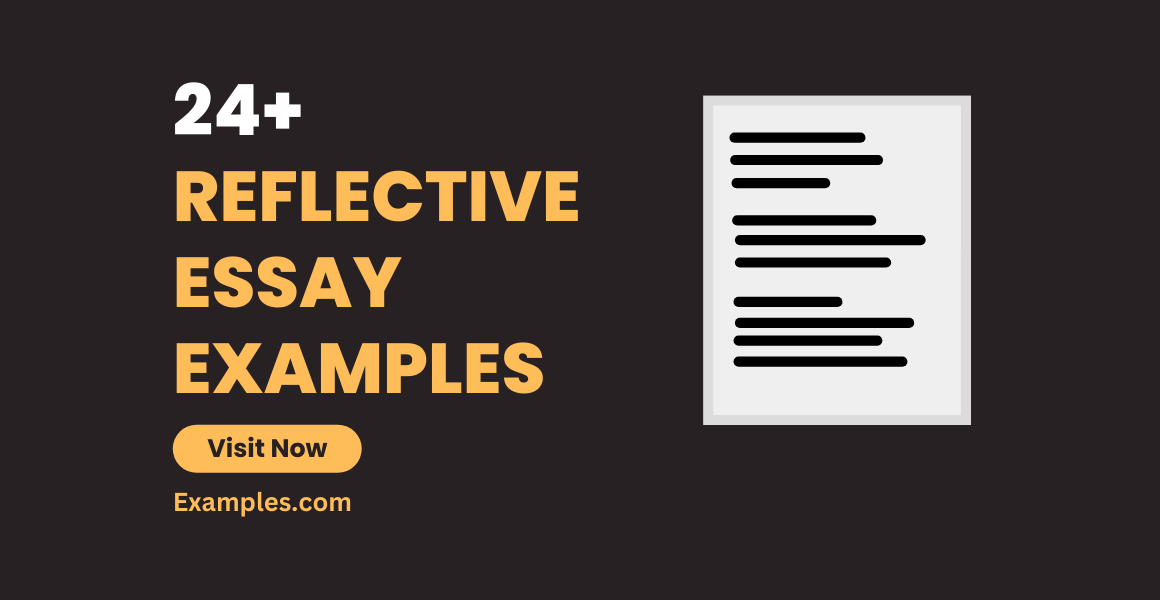
Sometimes, it is our experiences that startled and challenged our own voyage that strengthens and improves us to be the best versions of ourselves. If your life experience greatly moved you, there is a certain essay that allows you to compose your own endeavor. In this article, read through because we will be discussing the fundamentals of writing a reflective essay.
They say that being wise is better than being knowledgeable. Wisdom is acquired through reflection of one’s experience as well as of the environment. The more we reflect the more we become aware of ourselves. We become mindful of our existence as well as the meaning of life and all the things that surround us. Here we present different formats of essays like essays in doc .
Reflective Essay Outline Template

- Google Docs
Size: 188 KB
Reflective Essay About Life Experience
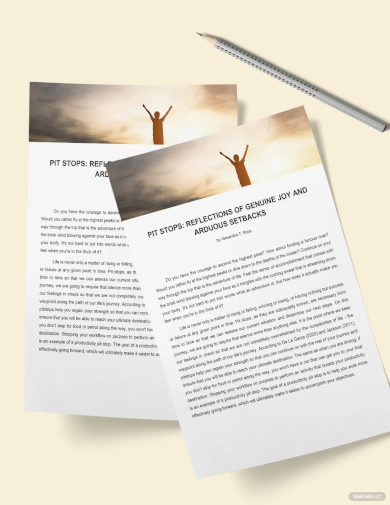
- Apple Pages
Size: 142 KB
Reflective Essay Template

Size: 237 KB
Self Reflective Essay Template
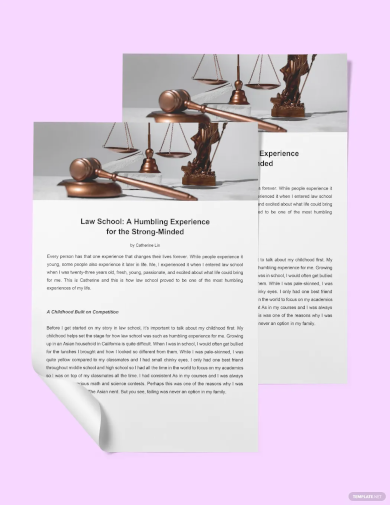
Size: 114 KB
Personal Reflective Essay Template
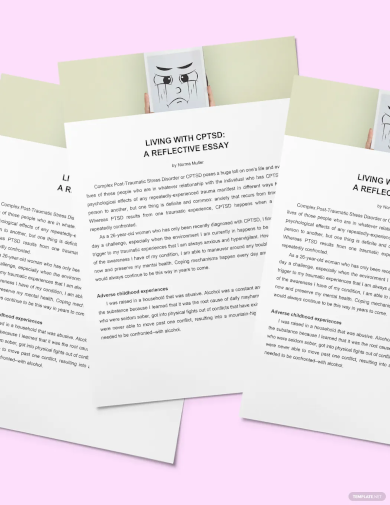
Size: 126 KB
Personal Reflective Sample
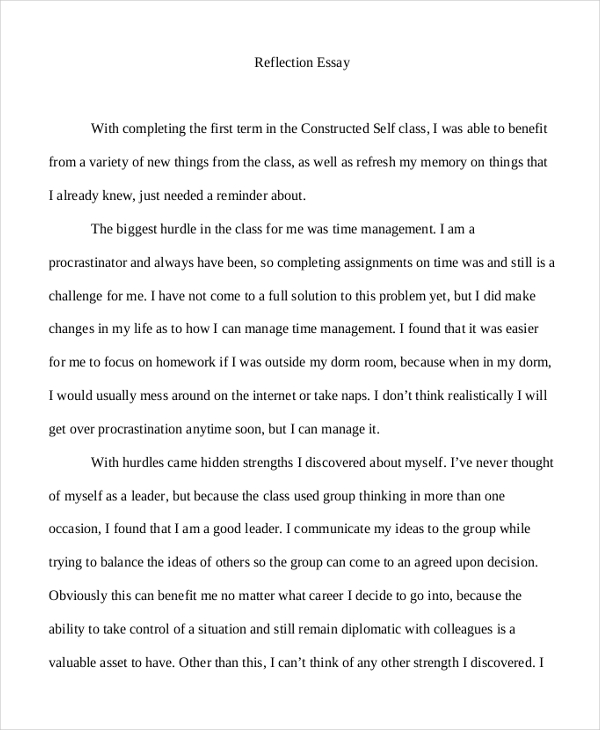
High School Essay

- PDFReflective Essay Example Reflective Essay Example Reflective Essay Example
Size: 102 KB
Reflective Essay Outline
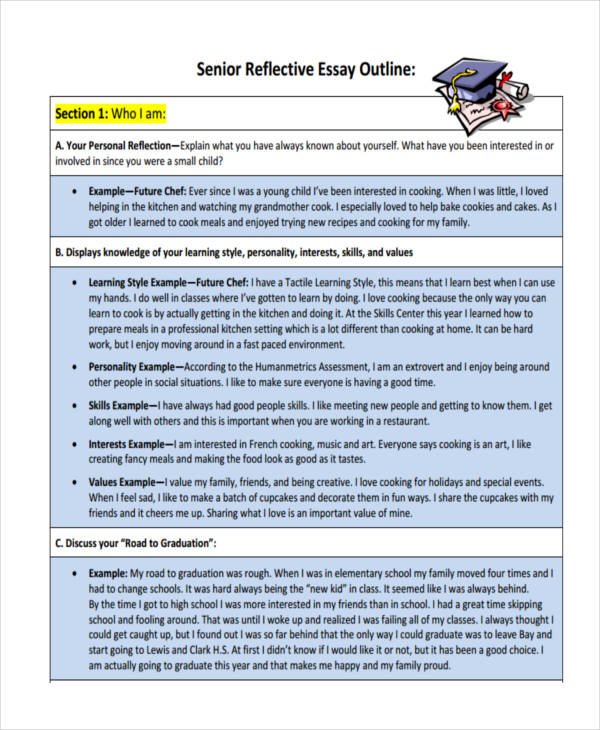
Size: 247 KB
Student Reflective Example
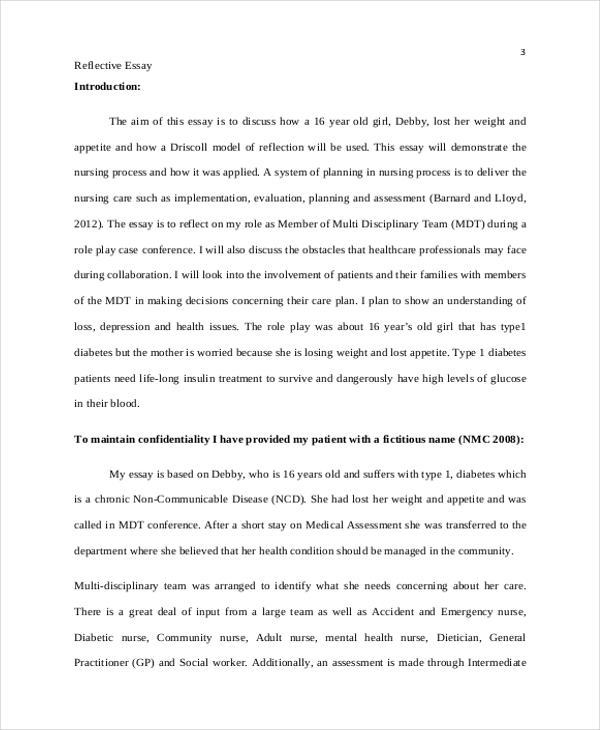
Size: 42 KB
Communication Reflective
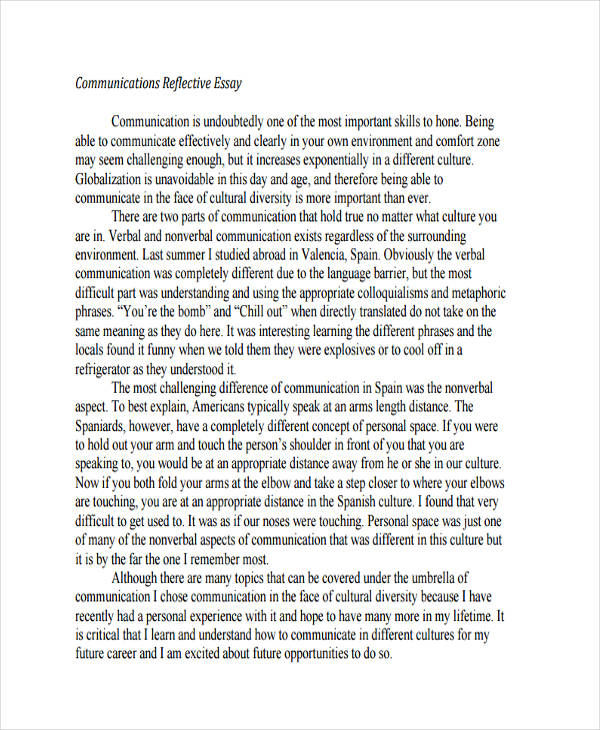
Size: 66 KB
What Is a Reflective Essay?
A reflective essay is a written piece of literature that focuses on presenting and narrating a person’s experience and how it becomes an instrument towards a change of perception in life.
It is a way for a writer to share an important event in his/her life and how it affected him/her so that others may learn something from it. Reflective writing root on life-changing events. The writer shares a specific experience, provides a narration of the incident including the material elements. It offers a realization so that others who may have had the same experience can draw out a shared mutual lesson from it.
How to Write a Reflective Essay
To write a reflective short essay , you need to have the right disposition as well as the momentum. Remember that you are not just writing to say something but to share an important lesson in life.
1. Think of an important event. What you will be writing on your reflective essay is something that is rooted in your own personal experience or encounter of something. Think deep and concentrate. You may also see personal essay examples & samples.
2. Introduce your topic. In your introduction, write the concrete event or experience that you want to share. Pattern it in a story form.
3. Develop your point. Write the main content of your essay with at least three to five paragraphs supporting your main topic.
Final Reflective Essay
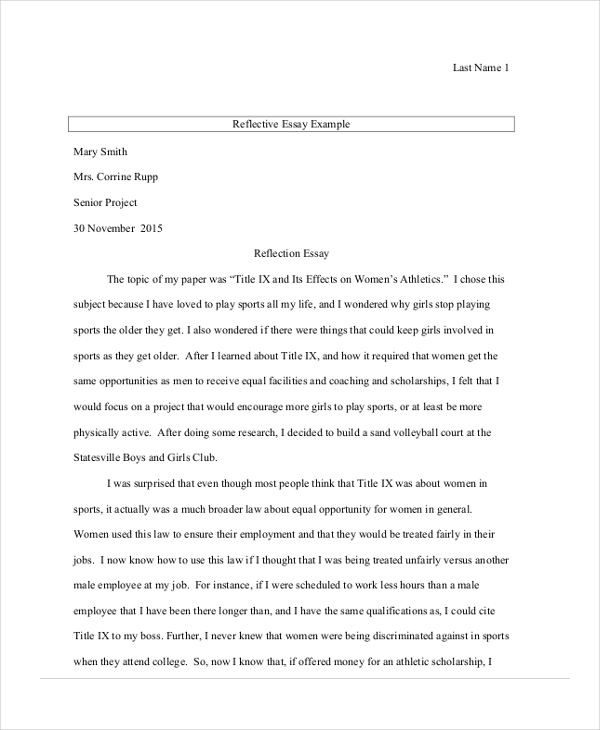
Size: 49 KB
Internship Reflective Essay
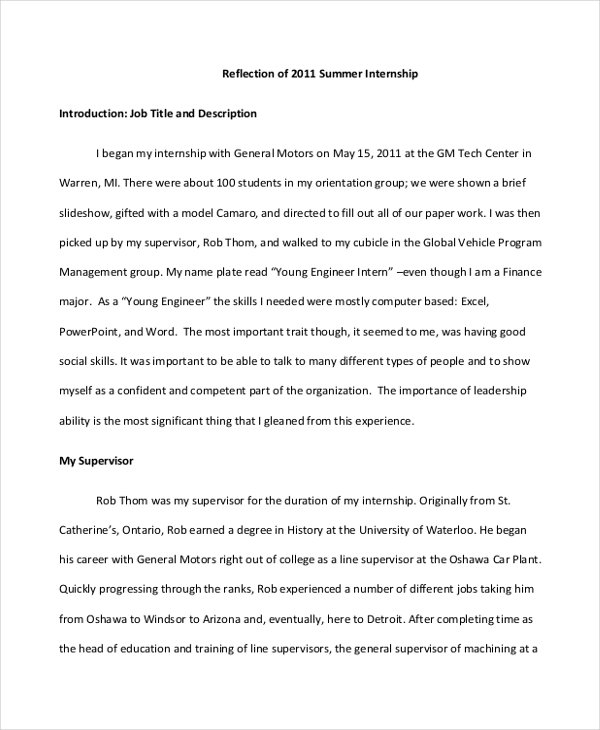
Size: 285 KB
Leadership Reflective Example
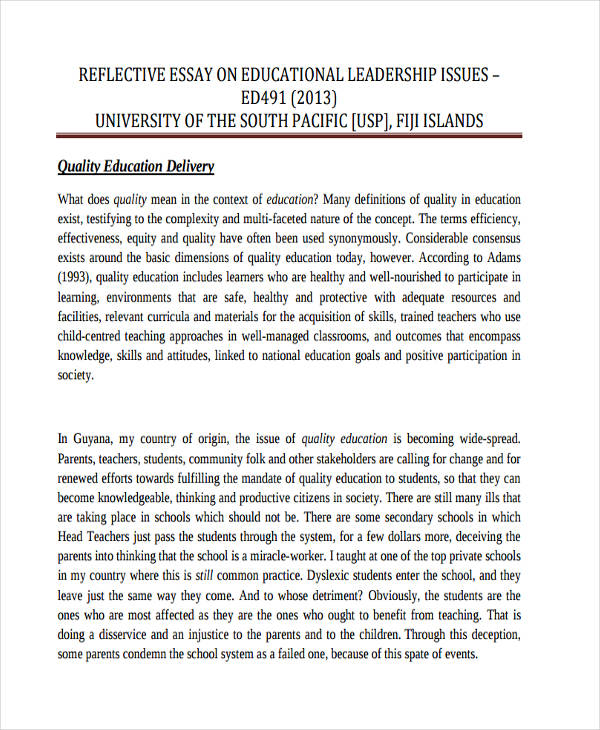
Size: 634 KB
Nursing Reflective Essay
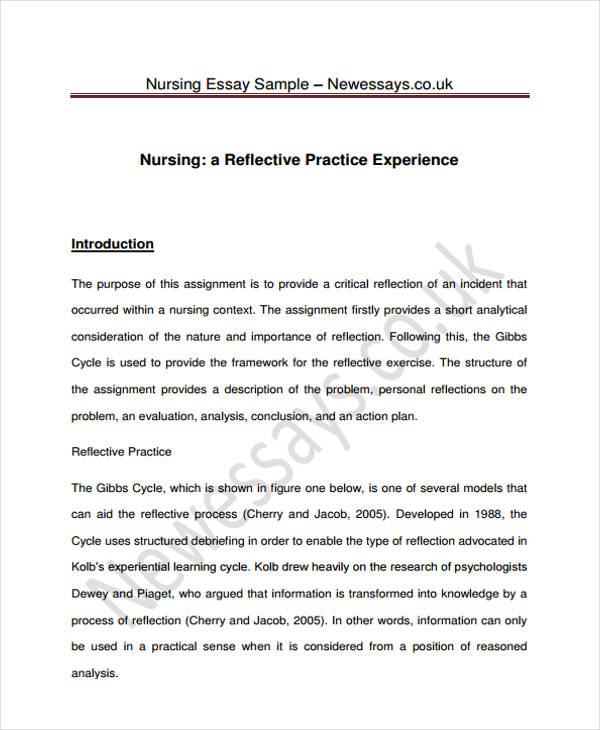
Size: 331 KB
Research Reflective Example
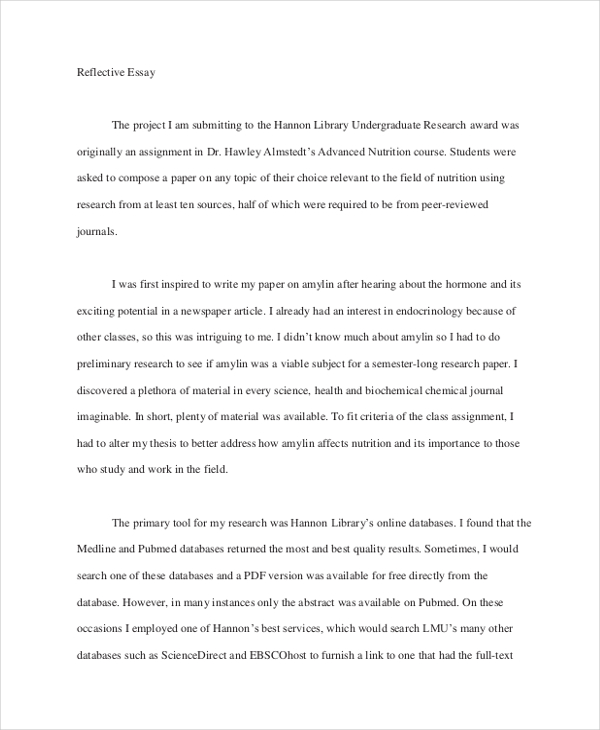
Size: 155 KB
Tips on Writing a Reflective Essay
Writing a reflective essay is not persuasive writing where you have to convince your readers to accept your opinion. You simply have to share an experience.
1. Write a draft. Do not jump hastily onto formal writing . Write a draft where you can create a bulleted list of the things that you want to share.
2. Think logically. When presenting a story, do it in a chronological manner so that your readers can understand the plot. Do this as well when presenting your ideas.
3. Create a summary. Use a summary writing to briefly state your insights and to give your final thoughts of the topic.
Importance of a Reflective Essay
In this era that we currently live in, personal reflection can be considered a thing of the past. Because of the gradual change and development of the things around us, we find it difficult to pause and reflect on the things that happen to our lives. You may also see academic essay examples .
The importance of writing an essay is to present to us the things that we rarely encounter in our day-to-day activities. In this time when material things are all that mattered, we have become unappreciative of the abstract things like love, compassion, and mercy. We cannot learn these things from those electronic gadgets that keep us busy.
How to Start a Reflective Essay Correctly
As mentioned above, a reflective essay presents and narrates the experience of a writer and how it changes the way he/she perceives life. In a simpler sense, it talks about how the author reflected on a certain adventure. As an essayist, since it’s you who bears the story and lessons, you are the one who is responsible for expressing it.
Just like any other composition, it’s your introduction that catches the attention of the reader. Thus, in order for your essay to be fully read, it is important to start your essay remarkably. If you find writing an introduction for your reflective essay challenging, don’t worry, you’re not alone. In this section, we are going to slowly tackle the ways to compose a compelling introduction.
1. Being catchy is the key.
In writing your reflective essay, you must start with something that would captivate the readers right away. Since the purpose of the introduction is to grab some attention, you may include some unique and interesting facts or beliefs. In this part, showcase your creativity by adding an introduction that is written in a bizarre manner and not those that depict cliché experience. You may also utilize a highly moving quotation or a dialogue that would also be appropriate for your reader.
2. Write the thesis statement in one sentence.
A thesis statement refers to the sentence that carries the topic being discussed in the whole essay. Therefore, it bears the central idea in which your essay revolves around. In writing your own essay, construct this statement in a clear and concise sentence. In this way, the reader will have a better grasp of your topic and would be clearly oriented on what you want to convey. In most cases, thesis statements are written at the end of the introduction.
3. Stick to the first person POV.
Remembering that this essay is subjective and depends on the author’s interpretation, it is important to use the first person point of view. By using this POV, it would be easier for you to convey your thoughts and opinions, and it would engage you to the readers like you’re telling a story in person. The first person involves the pronouns I , me , my , and mine .
4. Keep it brief.
When it comes to writing your own essay, you must perceive what your readers feel or see in reading your composition. Always put into mind that readers also have their own time to spend, and without a mark in the writing industry, people won’t invest much time on reading your essay. Thus, it is important to keep your composition concise. You can utilize a paragraph of five to ten sentences in your introduction. Using this number of sentences, you must already express a complete and clear thought of an essay that is worth reading.
Reflective Essay Example
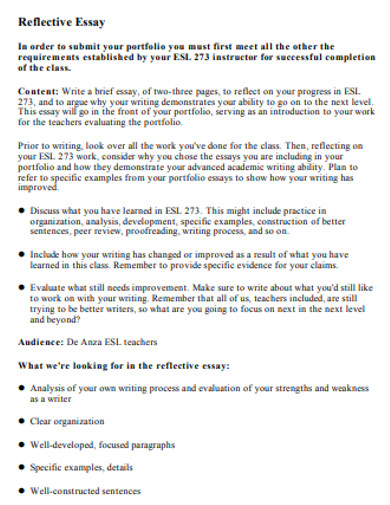
Size: 73 KB
Reflective Essay Assessment
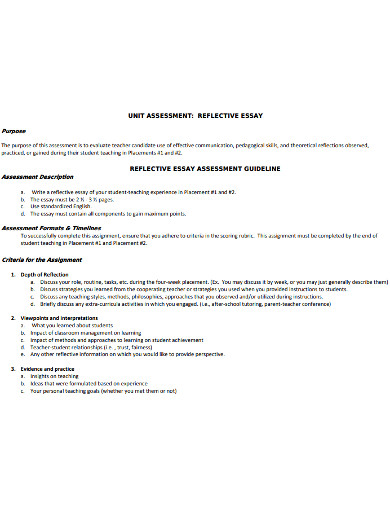
Size: 99 KB
Reflective Essay Format
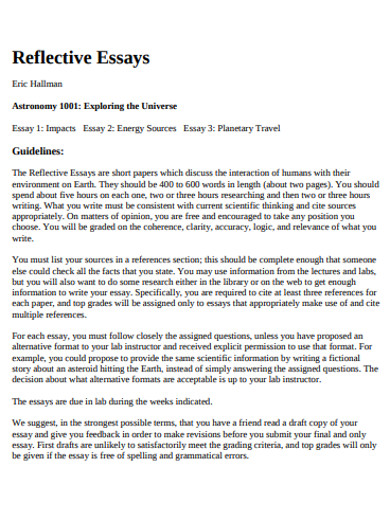
Size: 278 KB
Basic Reflective Essay
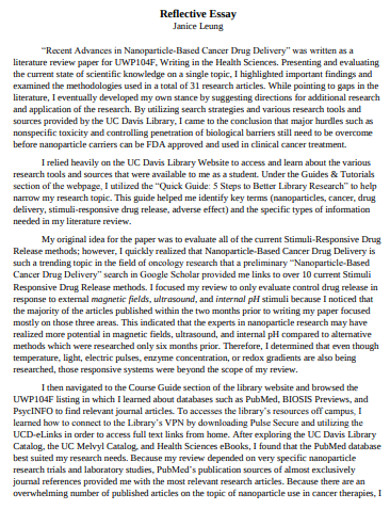
Size: 81 KB
Reflective Final Essay
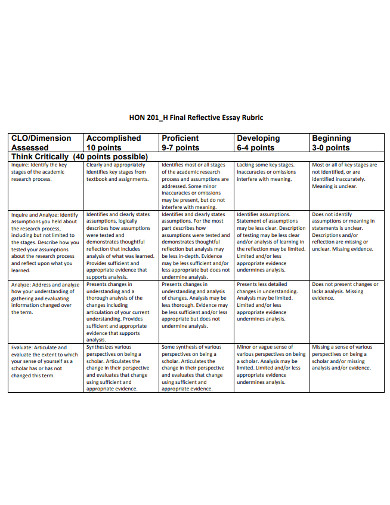
Size: 85 KB
Sample Reflective Essay
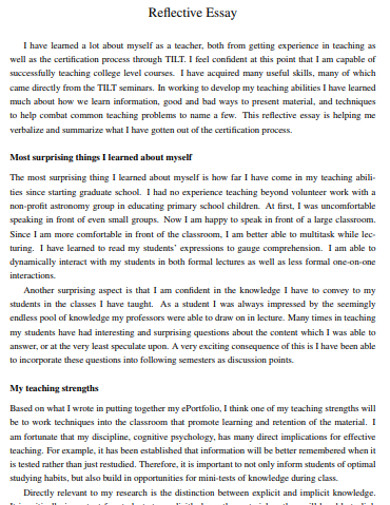
Size: 38 KB
Simple Reflective Essay Example
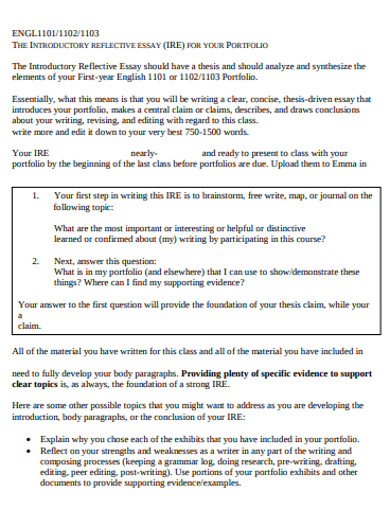
Size: 193 KB
Standard Reflective Essay
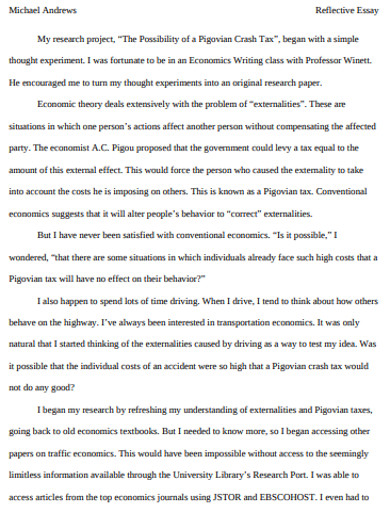
Professional Reflective Essay
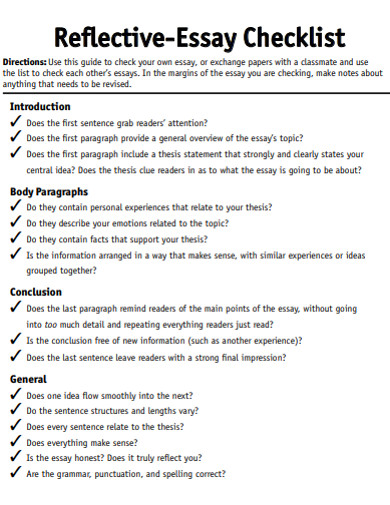
Size: 264 KB
Sample Reflective Essay in PDF
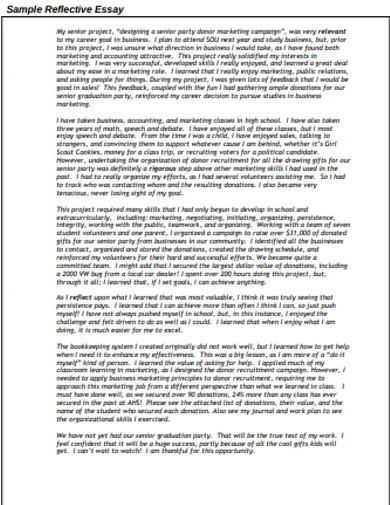
Size: 26 KB
Text prompt
- Instructive
- Professional
Write a Reflective Essay on your most meaningful learning experience.
Create a Reflective Essay about a time when you showed leadership.
Crafting a Personal Philosophy Statement
This essay is about crafting a personal philosophy statement, emphasizing self-reflection, clarity, and authenticity. It highlights the importance of understanding one’s core beliefs and values, presenting them clearly and honestly. The essay discusses how a philosophy statement serves as a compass, guiding personal and professional actions and decisions. It stresses the need for simplicity in expression, avoiding jargon, and the significance of authenticity through personal anecdotes. Additionally, it underscores the evolving nature of a philosophy statement, encouraging periodic revisions to keep it relevant. Ultimately, it illustrates how such statements can influence and enhance both personal growth and professional practice.
How it works
Creating a personal philosophy statement is a profound exercise in self-reflection and articulation of one’s core beliefs and values. It is not merely a document but a vivid representation of an individual’s guiding principles and ethical framework. This statement serves as a compass, providing direction and clarity in both personal and professional realms. As we delve into the art of crafting a philosophy statement, it becomes evident that this endeavor is a unique blend of introspection, clarity, and authenticity.
At the heart of a philosophy statement lies a deep understanding of one’s self. It requires an exploration of personal beliefs, experiences, and values that shape our worldview. This process is akin to peeling an onion, layer by layer, revealing the essence of what truly matters to us. It is essential to approach this task with an open mind and a willingness to confront our most fundamental convictions. This introspection is not always comfortable, but it is a necessary step in developing a philosophy that is genuine and reflective of our true selves.
When writing a personal philosophy statement, clarity and simplicity are paramount. The goal is to articulate complex beliefs in a manner that is both accessible and impactful. This does not mean simplifying the ideas themselves but rather presenting them in a clear and concise way. A well-crafted philosophy statement avoids jargon and overly complex language, opting instead for straightforward, honest expression. This clarity ensures that the statement resonates with both the writer and the reader, fostering a deeper connection and understanding.
Authenticity is another critical component of an effective philosophy statement. It is easy to fall into the trap of writing what we think others want to hear, especially in professional contexts. However, a philosophy statement should be a true reflection of our beliefs, not a tailored narrative designed to impress. Authenticity shines through when we write from the heart, sharing personal anecdotes and real-life examples that illustrate our principles. This personal touch not only adds depth to the statement but also makes it more relatable and impactful.
A personal philosophy statement is not static; it evolves as we grow and experience life. Our beliefs and values may shift over time, influenced by new insights, challenges, and achievements. Therefore, it is beneficial to revisit and revise the statement periodically, ensuring it remains aligned with our current perspective. This ongoing process of reflection and revision keeps the philosophy statement relevant and dynamic, much like our own personal development.
The impact of a well-crafted philosophy statement extends beyond personal reflection; it can significantly influence our professional life as well. For educators, for example, a teaching philosophy statement can guide their approach to instruction, classroom management, and student engagement. It provides a foundation for decision-making and helps maintain consistency in practice. In the corporate world, a leadership philosophy statement can inspire and motivate teams, fostering a positive and productive work environment. By clearly communicating our core values and expectations, we can build trust and credibility with those we lead or work alongside.
Crafting a personal philosophy statement is a deeply rewarding endeavor that demands honesty, clarity, and self-awareness. It is an opportunity to articulate what we stand for and why, providing a touchstone for our actions and decisions. Whether for personal reflection or professional guidance, a philosophy statement serves as a powerful tool for self-expression and growth. Embrace the process with an open heart and mind, and let your unique voice shine through in your words.
Cite this page
Crafting a Personal Philosophy Statement. (2024, Jun 01). Retrieved from https://papersowl.com/examples/crafting-a-personal-philosophy-statement/
"Crafting a Personal Philosophy Statement." PapersOwl.com , 1 Jun 2024, https://papersowl.com/examples/crafting-a-personal-philosophy-statement/
PapersOwl.com. (2024). Crafting a Personal Philosophy Statement . [Online]. Available at: https://papersowl.com/examples/crafting-a-personal-philosophy-statement/ [Accessed: 3 Jun. 2024]
"Crafting a Personal Philosophy Statement." PapersOwl.com, Jun 01, 2024. Accessed June 3, 2024. https://papersowl.com/examples/crafting-a-personal-philosophy-statement/
"Crafting a Personal Philosophy Statement," PapersOwl.com , 01-Jun-2024. [Online]. Available: https://papersowl.com/examples/crafting-a-personal-philosophy-statement/. [Accessed: 3-Jun-2024]
PapersOwl.com. (2024). Crafting a Personal Philosophy Statement . [Online]. Available at: https://papersowl.com/examples/crafting-a-personal-philosophy-statement/ [Accessed: 3-Jun-2024]
Don't let plagiarism ruin your grade
Hire a writer to get a unique paper crafted to your needs.

Our writers will help you fix any mistakes and get an A+!
Please check your inbox.
You can order an original essay written according to your instructions.
Trusted by over 1 million students worldwide
1. Tell Us Your Requirements
2. Pick your perfect writer
3. Get Your Paper and Pay
Hi! I'm Amy, your personal assistant!
Don't know where to start? Give me your paper requirements and I connect you to an academic expert.
short deadlines
100% Plagiarism-Free
Certified writers

IMAGES
VIDEO
COMMENTS
The writing process for composing a good synthesis essay requires curiosity, research, and original thought to argue a certain point or explore an idea. Synthesis essay writing involves a great deal of intellectual work, but knowing how to compose a compelling written discussion of a topic can give you an edge in many fields, from the social sciences to engineering.
Get multiple synthesis essay examples covering a range of topics. Learn how to craft an introduction, thesis, outlines, or write your entire synthesis essay.
Synthesis Essay Example. Here are two examples of synthesis essays that demonstrate how to apply the synthesis process in real life. They explore interesting topics and offer practical guidance for mastering the art of writing this type of paper. ... and various forms of academic essays including reflective and narrative essays. His expertise ...
It can be stressful, and it's not rare for students to panic and forget what to do. Don't worry, with these simple steps, you'll be able to create a great synthesis essay and ace your exam. 1. Scan the given sources. At first, you will be handed six sources that you're supposed to briefly examine.
The introduction should be short and precise, with the topic sentence in one paragraph. In the main body, the source material should be synthesized in 3-5 paragraphs. And the last component of a synthesis essay is the conclusion, where you should summarize your arguments, ideas, and thoughts.
The below synthesis essay examples are an excellent source of ideas for analysis and reflection. Besides, many of them contain a bibliography list. Thus, if your task matches some of the synthesis essay titles, you can use their references for your preliminary research.
The following tips can help you to write an effective synthesis essay: 1. Introduction: Start with an attention-grabbing hook that provides context for the essay, and introduce the topic and purpose of the essay. Provide a clear and concise thesis statement that summarizes the main argument or focus of the essay. 2.
Find several central ideas in the chart. Choose the ones that are repeated the most often and the ones that you feel need to be in your essay. Combine them, and you have a thesis statement with all the key points. Make a draft of the thesis statement. Try to formulate the main idea you want to present in your essay.
The two synthesis essay questions below are examples of the question type that has been one of the three free-response questions on the AP English Language and Composition Exam as of the May 2007 exam. The synthesis question asks students to synthesize information from a variety of sources to inform their own discussion of a topic. Students are given a 15-minute reading period to accommodate ...
Understanding What A Synthesis Essay Is. A synthesis essay is a special kind of academic writing where writers blend ideas and information from various sources to create a clear and organized argument.. Unlike other types of essays, a synthesis essay demands the integration of various perspectives to form a new understanding or insight.. It involves critically examining different sources, and ...
Below is a student sample of a synthesis essay. To see this document in appropriate MLA format, choose this link: Synthesis-Essay-Sample1. ... "The Changing America", is a clear reflection of the reality we live in today. The article is composed of different sections that focus on one of these trends; same sex marriage, cohabitation ...
Make a conclusion based on your analysis and synthesis. ... Reflective journals/diaries/blogs and other pieces of assessed reflection. The example structure above works particularly well for formal assignments such as reflective essays and reports. Reflective journal/blogs and other pieces of assessed reflections tend to be less formal both in ...
students better use synthesis in their writing and will offer strategies in the areas of: (1) pre-writing, (2) writing, (3) recognizing and (4) revising for synthesis. A common strategy for planning a synthesis paper is to create a "grid of common points." To create a grid follow these steps (note: be sure to see example grid on next page): 1.
Synthesis connects the day's learning to prior learning, helping students build schema and deepen their understanding. Reflection encourages metacognitive development by shifting the focus from the what of learning to the how. A synthesis prompt asks students to identify the important learning, summarize the learning, and articulate ...
Example of synthesizing sources. Let's take a look at an example where sources are not properly synthesized, and then see what can be done to improve it. Example: Poor synthesis. Lenneberg (1967) theorized that language acquisition could occur only within a critical period of development between infancy and puberty.
First, state your argument, make supporting statements, and back up each claim with reliable facts. 2. Review Essay. A review essay is frequently written as a preparatory essay to an argument synthesis. Review essays are commonly used in social science and medicine classes.
Reflection Essay — 1000-1250 words; include multiple links to examples from your workspace and quote yourself liberally in order to support your points.. Generative writing prompts — pick a few and reflect deeply, meaningfully, and honestly:. Is "good writing" a matter only of mechanics and grammar — "error-free" writing — or is it a reflection of rigorous, critical, and ...
Introduction. Reflective writing is considered to be effective for engaging students in the process of reviewing personal achievements and prospects for further development. The use of a case study format to reflect on the lessons learning is an academic task that requires synthesizing the relevant literature and one's knowledge and skills ...
Synthesis and reflection adam muhareb professor hutchinson engl 102 december 2020 for this essay have decided to read the following papers: corder, jim as. ... Synthesis and Reflection essay . Course: English 103 (ENGL103) 113 Documents. Students shared 113 documents in this course. University: MacEwan University. Info More info. Download.
1. Think of an important event. What you will be writing on your reflective essay is something that is rooted in your own personal experience or encounter of something. Think deep and concentrate. You may also see personal essay examples & samples. 2. Introduce your topic. In your introduction, write the concrete event or experience that you ...
Synthesis Integration And Reflections On Group Dynamics. We cannot talk about groups without including social psychology; to me these two terms go hand to hand. According to Forsyth (2006), the meaning of group is two or more people connected to one another by social relationships (p.3). Social psychology according to Baron, Byrne and ...
Creating a personal philosophy statement is a profound exercise in self-reflection and articulation of one's core beliefs and values. It is not merely a document but a vivid representation of an individual's guiding principles and ethical framework. This statement serves as a compass, providing direction and clarity in both personal and ...
Synthesis And Reflection Paper Example. Decent Essays. 1018 Words. 5 Pages. Open Document. Synthesis and Reflection on LEAD6163. This author has been involved in teaching and leadership activities as a member of the Port Orange Church of the Nazarene (PONAZ), a small church in eastern Florida. Florida Department of State, Division of ...